René Bosman Yvette Klinkenberg, Jie Dang; Ligtelijn, Do
Advanced measurements of rim-driven tunnel thrusters --The Wageningen TT-series JIP-- Conference
The 5th international conference on advanced model measurements technology (AMT '17) 11/13-10-2017, 2017.
@conference{Klinkenberg2017,
title = {Advanced measurements of rim-driven tunnel thrusters --The Wageningen TT-series JIP--},
author = {Yvette Klinkenberg, René Bosman, Jie Dang and Do Ligtelijn},
url = {http://www.marin.nl/web/Publications/Publication-items/Advanced-measurements-of-rimdriven-tunnel-thrusters-The-Wageningen-TTseries-JIP.htm},
year = {2017},
date = {2017-10-11},
booktitle = {The 5th international conference on advanced model measurements technology (AMT '17) 11/13-10-2017},
abstract = {For the Wageningen TT-series JIP a rim-driven tunnel thruster test set-up was used to evaluate the cavitation dynamics, underwater radiated noise levels (URN), pressure fluctuations on the inside of the tunnel, loads on the propeller, and dynamic generated side forces on the ship hull. Experiences with this complex test set-up are discussed in this paper. As there are too much elements in the set-up to be discussed down to the last detail, this paper will point out the general components and will go into detail on noise measurements and the calibration of a 6-component frame.
The calibration and check loads of one of the 6-component frames are presented. An elaborate paragraph on noise measurements discusses the calibration of the hydrophones, determination of the acoustic transfer of the set-up and signal quality. The analysis of the noise measurements showed disturbances in signals recorded by 2 out of 3 hydrophones. Although not yet completely pinpointed, these disturbances are ascribed to unwanted electromagnetic current, inadequate grounding or engine control switches. Other issues present during measurements were warming of bearings, Bernoulli effects between static and rotating segments of the set-up, and calcification and creep of sensors after long time submergence of the set-up. In the near future extra effort will be put in to tackle these challenges. Nevertheless, this complex set-up with in-house developed, as well as off the shelf sensors answers to the demanding research questions asked in the TT JIP.},
keywords = {},
pubstate = {published},
tppubtype = {conference}
}
The calibration and check loads of one of the 6-component frames are presented. An elaborate paragraph on noise measurements discusses the calibration of the hydrophones, determination of the acoustic transfer of the set-up and signal quality. The analysis of the noise measurements showed disturbances in signals recorded by 2 out of 3 hydrophones. Although not yet completely pinpointed, these disturbances are ascribed to unwanted electromagnetic current, inadequate grounding or engine control switches. Other issues present during measurements were warming of bearings, Bernoulli effects between static and rotating segments of the set-up, and calcification and creep of sensors after long time submergence of the set-up. In the near future extra effort will be put in to tackle these challenges. Nevertheless, this complex set-up with in-house developed, as well as off the shelf sensors answers to the demanding research questions asked in the TT JIP.
Brouwer, Joris; Tukker, Jan
Random uncertainty of variance of finite length measurement signals Conference
The 5th international conference on advanced model measurements technology (AMT '17) 11/13-10-2017, 2017.
@conference{Brouwer2017,
title = {Random uncertainty of variance of finite length measurement signals},
author = {Joris Brouwer and Jan Tukker},
url = {http://www.marin.nl/web/Publications/Publication-items/Random-uncertainty-of-variance-of-finite-length-measurement-signals.htm},
year = {2017},
date = {2017-10-11},
booktitle = {The 5th international conference on advanced model measurements technology (AMT '17) 11/13-10-2017},
abstract = {When considering stationary measurements, the finite length of any practical measurement imposes a random uncertainty component to statistical quantities being researched. In other words, repeating the same experiment will result in a slightly different answer. This happens for example when the limiting factor is facility length (e.g. performing resistance measurements in a towing tank) or when the limiting factor is time (e.g. offshore platform motions in a wave basin).
This paper is the fourth in a series of papers considering the analytical derivation and practical estimation of such statistical uncertainties. The previous three papers considered mean values of
random processes. This fourth paper considers variance instead and is analogous to the first paper of the series. Both random and periodic process classes are considered. The analytical derivation of the statistical uncertainty of signal variance is given for random, finite bandwidth noise processes and periodic processes. The former is a general solution while the latter is only valid for the trivial case of sinusoid signals. The reason to include periodic solution is its significant deviation from the finite bandwidth solution. The analytical solutions are verified by means of artificially generated signals. In general, the uncertainty of variance for finite bandwidth processes reduce with the square root of the signal length once measurement length exceeds the inverse bandwidth of the process. Measuring too short may result in a standard uncertainty equal to the variance itself. For periodic signals, the uncertainty of variance reduces with signal length itself. Estimating methods to find the statistical uncertainty of signal variance from a single measurement are given for both classes of processes. The analytic solutions and estimating methods are verified with artificially created signals. The presented uncertainty estimators are able to yield reliable and accurate estimates of the 95% confidence intervals.},
keywords = {},
pubstate = {published},
tppubtype = {conference}
}
This paper is the fourth in a series of papers considering the analytical derivation and practical estimation of such statistical uncertainties. The previous three papers considered mean values of
random processes. This fourth paper considers variance instead and is analogous to the first paper of the series. Both random and periodic process classes are considered. The analytical derivation of the statistical uncertainty of signal variance is given for random, finite bandwidth noise processes and periodic processes. The former is a general solution while the latter is only valid for the trivial case of sinusoid signals. The reason to include periodic solution is its significant deviation from the finite bandwidth solution. The analytical solutions are verified by means of artificially generated signals. In general, the uncertainty of variance for finite bandwidth processes reduce with the square root of the signal length once measurement length exceeds the inverse bandwidth of the process. Measuring too short may result in a standard uncertainty equal to the variance itself. For periodic signals, the uncertainty of variance reduces with signal length itself. Estimating methods to find the statistical uncertainty of signal variance from a single measurement are given for both classes of processes. The analytic solutions and estimating methods are verified with artificially created signals. The presented uncertainty estimators are able to yield reliable and accurate estimates of the 95% confidence intervals.
H. Abreu, Eça; Klaij, C. M.
20th Numerical Towing Tank Symposium (NuTTS), Wageningen, The Netherlands, 2017.
@conference{Abreu2017,
title = {Code Verification Exercise of a Navier-Stokes Solver for Compressible Flows in the Laminar and Subsonic Regimes},
author = {Abreu, H., Eça, L., and Klaij, C.M.},
url = {http://www.marin.nl/web/Publications/Publication-items/Code-Verification-Exercise-of-a-NavierStokes-Solver-for-Compressible-Flows-in-the-Laminar-and-Subsonic-Regimes.htm},
year = {2017},
date = {2017-10-03},
booktitle = {20th Numerical Towing Tank Symposium (NuTTS), Wageningen, The Netherlands},
abstract = {Many of the flows of interest to the naval and offshore industries deal with fluids that are usually assumed to be incompressible. However, there are several phenomena, as for example slamming, sloshing or cavitation where the fluid compressibility must be taken into account. All these applications involve compressible two-phase flows, which are the ultimate goal of the present development of the flow solver ReFRESCO.
As a first step of this development, this paper presents a Code Verification exercise performed with the Method of Manufactured Solutions, for laminar compressible flows in the subsonic regime. This first extension of ReFRESCO for a fluid that obeys the perfect gas equation of state requires two steps: 1. Adaptation of the SIMPLE algorithm used to determine the pressure field. 2. Solution of the energy equation to determine the temperature field.
This first step of the development is well documented in the open literature for both single phase and multiphase flows. On the other hand, the energy equation is already available in ReFRESCO but it is seldom solved in incompressible flow solutions. However, its formulation must be updated due to the change of the equation of state. Nonetheless, the present paper presents one more manufactured solution for the Verification of compressible solvers and guarantees that we start this development with a good basis.},
keywords = {},
pubstate = {published},
tppubtype = {conference}
}
As a first step of this development, this paper presents a Code Verification exercise performed with the Method of Manufactured Solutions, for laminar compressible flows in the subsonic regime. This first extension of ReFRESCO for a fluid that obeys the perfect gas equation of state requires two steps: 1. Adaptation of the SIMPLE algorithm used to determine the pressure field. 2. Solution of the energy equation to determine the temperature field.
This first step of the development is well documented in the open literature for both single phase and multiphase flows. On the other hand, the energy equation is already available in ReFRESCO but it is seldom solved in incompressible flow solutions. However, its formulation must be updated due to the change of the equation of state. Nonetheless, the present paper presents one more manufactured solution for the Verification of compressible solvers and guarantees that we start this development with a good basis.
S. Burmester, Gueydon; El Moctar, B
Surge Decay Simulations of a Semi-Submersible Floating Offshore Wind Turbine Conference
20th Numerical Towing Tank Symposium (NuTTS), Wageningen, The Netherlands, 2017.
@conference{Burmester2017,
title = {Surge Decay Simulations of a Semi-Submersible Floating Offshore Wind Turbine},
author = {Burmester, S., Gueydon, S., Vaz, G. and El Moctar, B},
url = {http://www.marin.nl/web/Publications/Publication-items/Surge-Decay-Simulations-of-a-SemiSubmersible-Floating-Offshore-Wind-Turbine.htm},
year = {2017},
date = {2017-10-03},
booktitle = {20th Numerical Towing Tank Symposium (NuTTS), Wageningen, The Netherlands},
abstract = {The OC5 (Offshore Code Comparison, Collaboration, Continued, with Correlation) project was focused on the validation of numerical simulations of the DeepCwind semi-submersible floating wind turbine with experimental data obtained from physical tests performed at the facilities of MARIN. In this paper the focus lies on the prediction of the hydrodynamic damping for surge motion. It is assumed that the hydrodynamic damping consists of wave radiation damping, viscous damping and drag of the mooring lines. The viscous damping cannot be predicted by potential flow based methods. On these grounds, the viscous flow solver ReFRESCO is used to simulate the surge decay test of the OC5 semi-submersible floating wind turbine. There are many mooring models available with lots of different properties. Dynamic mooring models are needed to account for the drag of the mooring lines moving in water. For this work the moorings are considered with a linear stiffness matrix in the equations of motion, i.e. no drag of the mooring lines is considered in the current study. Nevertheless, several surge decay simulations are performed to understand the effects of scaling and wave radiation on the hydrodynamic damping. Numerical results are compared with the above mentioned experimental data.},
keywords = {},
pubstate = {published},
tppubtype = {conference}
}
L. Eça, Vaz; Hoekstra, M.
Iterative Errors in Unsteady Flow Simulations: Are they Really Negligible? Conference
20th Numerical Towing Tank Symposium (NuTTS), Wageningen, The Netherlands, 2017.
@conference{Eça2017,
title = {Iterative Errors in Unsteady Flow Simulations: Are they Really Negligible?},
author = {Eça, L., Vaz, G. and Hoekstra, M.},
url = {http://www.marin.nl/web/Publications/Publication-items/Iterative-Errors-in-Unsteady-Flow-Simulations-Are-they-Really-Negligible.htm},
year = {2017},
date = {2017-10-03},
booktitle = {20th Numerical Towing Tank Symposium (NuTTS), Wageningen, The Netherlands},
abstract = {The numerical solution of a statistically steady flow problem is typically obtained in an iterative process. For a given mathematical model, including boundary conditions, the accuracy of the solution is governed by spatial resolution of the grid, spatial discretisation schemes and the convergence tolerance, which says when the solution is considered to have reached a steady state. Next to hardware quality (round-off error), the discretisation error and the iterative error determine the quality of the solution. For unsteady flow problems matters are more complicated. Temporal and spatial resolution have to be chosen carefully in proper balance. Moreover, in high Reynolds number (turbulent) flows, time integration is usually performed with implicit schemes, which require the solution of a non-linear system of equations at each time step. Again a convergence tolerance is needed to decide on when having solved this nonlinear system well enough. Any iterative error propagates to the next time step. How does one guarantee reliability of the results?
This paper summarizes the main results of this first Workshop on Iterative Errors in Unsteady Flow Simulations. It presents a brief description of the proposed test case and the selected quantities of interest and an overview of some of the submitted data. The paper is also meant as an encouragement for participants of the NUTTS symposium to take part in the second edition of the Workshop that will take place at the ASME V&V Symposium of 2018.},
keywords = {},
pubstate = {published},
tppubtype = {conference}
}
This paper summarizes the main results of this first Workshop on Iterative Errors in Unsteady Flow Simulations. It presents a brief description of the proposed test case and the selected quantities of interest and an overview of some of the submitted data. The paper is also meant as an encouragement for participants of the NUTTS symposium to take part in the second edition of the Workshop that will take place at the ASME V&V Symposium of 2018.
B. Vink, Schot; Toxopeus, S. L.
A Verification and Validation Study of CFD Simulations for the Flow Around A Tug Conference
20th Numerical Towing Tank Symposium (NuTTS), Wageningen, The Netherlands, 2017.
@conference{Vink2017,
title = {A Verification and Validation Study of CFD Simulations for the Flow Around A Tug},
author = {Vink, B., Schot, J., Vaz, G. and Toxopeus, S.L.},
url = {http://www.marin.nl/web/Publications/Publication-items/A-Verification-and-Validation-Study-of-CFD-Simulations-for-the-Flow-Around-A-Tug.htm},
year = {2017},
date = {2017-10-03},
booktitle = {20th Numerical Towing Tank Symposium (NuTTS), Wageningen, The Netherlands},
abstract = {An important vessel for the operational process in a harbour is the tug, a vessel built for the specific purpose of quickly manoeuvring larger vessels in waterways. The key features of a tug are the towing and escorting performances under optimal conditions, which are often reached when sailing under drift at high Froude numbers. Potential users or buyers are comparing tugs on these key features. Thus, for tug designers it is of significant importance to correctly predict the performance of new designs, therewith enabling themselves to verify possible improvements. These predictions, based on lift and drag characteristics of the hull and appendages, are frequently performed using free running or captive model tests, which can be expensive, give no thorough insight in flow specifics and although large-scale models are used still suffer from scale effects. An alternative approach is the use of viscous flow computations, also called Computational Fluid Dynamics (CFD).
This present work will initially estimate the experimental uncertainties from captive model tests to obtain correct validation material. Thereafter a verification and validation exercise of free surface simulations with the KSKL turbulence model and a drift angle of 15 deg will be presented. These are followed by a turbulence sensitivity study of the KSKL, SST, EARSM and DDES turbulence model and finally simulations at other drift angles with the KSKL turbulence will be presented.},
keywords = {},
pubstate = {published},
tppubtype = {conference}
}
This present work will initially estimate the experimental uncertainties from captive model tests to obtain correct validation material. Thereafter a verification and validation exercise of free surface simulations with the KSKL turbulence model and a drift angle of 15 deg will be presented. These are followed by a turbulence sensitivity study of the KSKL, SST, EARSM and DDES turbulence model and finally simulations at other drift angles with the KSKL turbulence will be presented.
C. Negrato, Van Terwisga; Bensow, R.
Analysis of Hydrofoil Cavitation using Proper Orthogonal Decomposition Conference
20th Numerical Towing Tank Symposium (NuTTS), Wageningen, The Netherlands, 2017.
@conference{Negrato2017b,
title = {Analysis of Hydrofoil Cavitation using Proper Orthogonal Decomposition},
author = {Negrato, C., Van Terwisga, T.J.C. and Bensow, R.},
url = {http://www.marin.nl/web/Publications/Publication-items/Analysis-of-Hydrofoil-Cavitation-using-Proper-Orthogonal-Decomposition.htm},
year = {2017},
date = {2017-10-03},
booktitle = {20th Numerical Towing Tank Symposium (NuTTS), Wageningen, The Netherlands},
abstract = {Cavitation is the change of phase from liquid to vapor when the pressure falls below the saturation pressure. For marine propellers, occurrence of cavitation is accepted on modern designs. However, there is a need to keep cavitation under control, because its extent can influence propeller efficiency, as well as lead to undesired phenomena such as increased noise and erosion. To understand the dynamics of cavitation, researchers often focus on cavitation on simpler geometries, such as hydrofoils. In this work, the test case consists on a two dimensional NACA0015 hydrofoil. The results from a viscous flow simulation are considered here; the scope is to gain additional insight into cavitation dynamics in a regime of cavity shedding, by applying a Proper Orthogonal Decomposition (POD) technique. POD is used for analysis of experimental data or CFD results and relies on the approximation of the flow field by a linear combination of basis functions which are representative of flow structures.
This paper provides a description of the numerical setup and the basic theoretical background for POD and shows the outcome of orthogonal decomposition for two scalar fields: the vapor volume fraction and the pressure coefficient.},
keywords = {},
pubstate = {published},
tppubtype = {conference}
}
This paper provides a description of the numerical setup and the basic theoretical background for POD and shows the outcome of orthogonal decomposition for two scalar fields: the vapor volume fraction and the pressure coefficient.
Rotte, G.; Kerkvliet, M.; Van Terwisga, T. J. C.
On the Turbulence Modelling for an Air Cavity Interface Conference
20th Numerical Towing Tank Symposium (NuTTS), Wageningen, The Netherlands, 2017.
@conference{Rotte2017,
title = {On the Turbulence Modelling for an Air Cavity Interface},
author = {Rotte, G. and Kerkvliet, M. and Van Terwisga, T.J.C.},
url = {http://www.marin.nl/web/Publications/Publication-items/On-the-Turbulence-Modelling-for-an-Air-Cavity-Interface.htm},
year = {2017},
date = {2017-10-03},
booktitle = {20th Numerical Towing Tank Symposium (NuTTS), Wageningen, The Netherlands},
abstract = {The use of air lubrication techniques can significantly reduce a ship’s fuel consumption. One of the most promising techniques applicable to ships is the external air cavity technique. An external cavity is created beneath the ship’s hull with the help of a cavitator, which is located directly upstream of an air injection point (figure 1a). The cavitator is extended in the span-wise direction and typically has a rectangular or triangular cross section. It is used to separate the mean water flow from the hull, thereby providing a stable air layer. Air cavity applications are claimed to lead to propulsive power reduction percentages of 10-20% by reducing the ship’s frictional drag. However, a complete understanding of the influence that the ship’s hull form has on the relevant twophase flow physics and thereby also on the length and stability of the air cavities is still lacking. This inability to predict the air cavity characteristics hampers the application of air cavity techniques in the shipping industry. Multiphase CFD methods can help us to gain a better understanding of the relevant physics.
This article aims to link the physical modelling of the relevant phenomena to their numerical modelling, with an emphasis on the modelling of the re-entrant jet mechanism with a RaNS turbulence model. The article is based on the available literature in the public domain and on knowledge gained from research projects carried out at Delft University of Technology and at the Maritime Research Institute Netherlands (MARIN).},
keywords = {},
pubstate = {published},
tppubtype = {conference}
}
This article aims to link the physical modelling of the relevant phenomena to their numerical modelling, with an emphasis on the modelling of the re-entrant jet mechanism with a RaNS turbulence model. The article is based on the available literature in the public domain and on knowledge gained from research projects carried out at Delft University of Technology and at the Maritime Research Institute Netherlands (MARIN).
M. Klapwijk, Rotte; Van Terwisga, T.
Modelling of the Plume of a Submerged Exhaust System Conference
20th Numerical Towing Tank Symposium (NuTTS), Wageningen, The Netherlands, 2017.
@conference{Klapwijk2017,
title = {Modelling of the Plume of a Submerged Exhaust System},
author = {Klapwijk, M., Rotte, G., Kerkvliet, M. and Van Terwisga, T.},
url = {http://www.marin.nl/web/Publications/Publication-items/Modelling-of-the-Plume-of-a-Submerged-Exhaust-System.htm},
year = {2017},
date = {2017-10-03},
booktitle = {20th Numerical Towing Tank Symposium (NuTTS), Wageningen, The Netherlands},
abstract = {The Royal Netherlands Navy (RNN) currently operates four diesel-electric Walrus class submarines. The submarines sail submerged on electric engines and periodically recharge the batteries with diesel engines at periscope depth. While recharging, air is taken in with a snorkel mast and exhaust gases are dispelled at the back of the sail, below water level.
To enable evaluating several exhaust configurations the Defence Material Organisation (DMO), responsible for the design and maintenance of the fleet of the RNN, has expressed desire in a numerical model to predict the surface elevation.
The numerical modelling is divided in two sections. First a turbulent jet is modelled to determine the required numerical settings, secondly the submarine simulations are performed. This article describes the influence of different turbulence models on the turbulent jet, the verification of the turbulent jet, and the validation of the submarine simulations with experimental data obtained by MARIN.},
keywords = {},
pubstate = {published},
tppubtype = {conference}
}
To enable evaluating several exhaust configurations the Defence Material Organisation (DMO), responsible for the design and maintenance of the fleet of the RNN, has expressed desire in a numerical model to predict the surface elevation.
The numerical modelling is divided in two sections. First a turbulent jet is modelled to determine the required numerical settings, secondly the submarine simulations are performed. This article describes the influence of different turbulence models on the turbulent jet, the verification of the turbulent jet, and the validation of the submarine simulations with experimental data obtained by MARIN.
R. Lopes, Eça; Vaz, G.
On the Decay of Freestream Turbulence Predicted by Two-equation Eddy-viscosity Models Conference
20th Numerical Towing Tank Symposium (NuTTS), Wageningen, The Netherlands, 2017.
@conference{Lopes2017,
title = {On the Decay of Freestream Turbulence Predicted by Two-equation Eddy-viscosity Models},
author = {Lopes, R., Eça, L. and Vaz, G.},
url = {http://www.marin.nl/web/Publications/Publication-items/On-the-Decay-of-Freestream-Turbulence-Predicted-by-Twoequation-Eddyviscosity-Models.htm},
year = {2017},
date = {2017-10-03},
booktitle = {20th Numerical Towing Tank Symposium (NuTTS), Wageningen, The Netherlands},
abstract = {As reported before by Spalart and Rumsey, the decay of freestream turbulence in two-equation eddy-viscosity turbulence models is overestimated. In simulations of external flows at high Reynolds numbers that assume "fully turbulent" flow, this excessive decay has a negligible impact on the solution. The laminar regime is confined to a very small region near the leading edge of the body and so the correct prediction of transition is not relevant. On the other hand, in model scale experiments it is common practice to force transition through the use of trip wires or roughness. Therefore, the incorrect prediction of the transition location by two-equation eddy-viscosity models becomes an asset instead of a problem.
This known shortcoming of the most common turbulence models led to the development of transition models, which supplement the two-equation eddy-viscosity SST model. Its local formulation and capability to account for several transition mechanisms such as natural transition, bypass transition and separation-induced transition make it an attractive option. The onset of transition is strongly dependent on the level of the free-stream turbulence intensity, which makes the excessive decay of turbulence predicted by the SST model troublesome.
In this paper we present the first step of this development that is performed for the flow over a flat plate, for which there are experimental data available for transitional flows with different levels of freestream turbulence in the ERCOFTAC Classic Database.},
keywords = {},
pubstate = {published},
tppubtype = {conference}
}
This known shortcoming of the most common turbulence models led to the development of transition models, which supplement the two-equation eddy-viscosity SST model. Its local formulation and capability to account for several transition mechanisms such as natural transition, bypass transition and separation-induced transition make it an attractive option. The onset of transition is strongly dependent on the level of the free-stream turbulence intensity, which makes the excessive decay of turbulence predicted by the SST model troublesome.
In this paper we present the first step of this development that is performed for the flow over a flat plate, for which there are experimental data available for transitional flows with different levels of freestream turbulence in the ERCOFTAC Classic Database.
Frans Hendrik Lafeber, Thomas Lloyd; Bosschers, Johan
Inter.Noise Hongkong 27-30 August, no. ID682, 2017.
@conference{Lafeber2017b,
title = {Validation of underwater radiated noise predictions for a merchant vessel using full-scale measurements},
author = {Frans Hendrik Lafeber, Thomas Lloyd and Johan Bosschers},
url = {http://www.marin.nl/web/Publications/Publication-items/Validation-of-underwater-radiated-noise-predictions-for-a-merchant-vessel-using-fullscale-measurements.htm},
year = {2017},
date = {2017-08-27},
booktitle = {Inter.Noise Hongkong 27-30 August},
number = {ID682},
abstract = {Underwater radiated noise (URN) was previously primarily of interest in connection with the signature of naval vessels. Recently it has become increasingly relevant for other vessel types, such as cruise and merchant ships, due to a growing concern that marine life is affected by rising anthropogenic noise levels in the oceans. Shipping is a main contributor to those noise levels, with the cavitating propeller being the dominant noise source. Marine mammals and fish use sound to communicate and to sense their environment and this requires low background noise levels. The URN of a cavitating propeller can be predicted before the ship is built by means of computations and model-scale tests. High-quality validation material is needed for the validation of computational models and model test procedures, which include the scaling of the noise levels. Within the CRS framework (Cooperative Research Ships, http://www.crships.org/) a full-scale measurement campaign was carried out on a single-screw cargo vessel by DNV-GL, DAMEN and MARIN. Model tests for several conditions have been carried out in MARIN’s Depressurized Wave Basin. During these tests, URN was measured and cavitation patterns were observed using high-speed video cameras. Within the CRS a semi-empirical model has also been developed, which predicts the broadband pressure fluctuations and URN of cavitating tip vortices on marine propellers. This paper discusses a validation study of the computational and model test procedures for determining URN due to cavitating propellers, using the full-scale data of the aforementioned ship. Some aspects of the analysis and scaling procedures are discussed. Results are shown for three pitch settings. The agreement between the results of the various methods is very good; mostly within 3 dB. The change in noise levels between the three tested conditions is well captured.},
keywords = {},
pubstate = {published},
tppubtype = {conference}
}
Abeil, Bastien
Experimental determination of water motions inside a moonpool Conference
Proceedings of the ASME 2017 36th International Conference on Ocean, Offshore and Arctic Engineering OMAE2017 , 2017.
@conference{Abeil2017,
title = {Experimental determination of water motions inside a moonpool},
author = {Bastien Abeil },
url = {http://www.marin.nl/web/Publications/Publication-items/Experimental-determination-of-water-motions-inside-a-moonpool.htm},
year = {2017},
date = {2017-06-25},
booktitle = {Proceedings of the ASME 2017 36th International Conference on Ocean, Offshore and Arctic Engineering OMAE2017
},
abstract = {The substantial water motions that can occur inside a moonpool when a ship is operating in a formed sea represent a critical issue for operators, as they imply an interruption of subsea activities (e.g. delay in ROV deployment) or even a threat to the survival of the equipment placed inside or around the moonpool (e.g. riser connected to a BOP). In a perspective of reducing downtime caused by moonpool inactivity, substantial effort has been made over the past year to better understand the circumstances of such water dynamics and devise mitigation measures. Works of among others Fukuda [1] or Molin [2] show that the moonpool motions can be described as either piston mode, in other words a vertical displacement of the water column, or as horizontal sloshing modes, which natural frequencies can be approximated by closed-form expressions involving moonpool geometry and draught. The effect of damping devices, such as side wall flanges, has been widely investigated, notable publications include those of Fukuda [1] and Aalbers [3].
State-of-the-art prediction of moonpool flows has undergone some significant changes over the last years. Away from analytical formulations (Aalbers [3]) and potential flow, the industry is nowadays moving towards the more advanced viscous flow methods, which allow a more complete description of the flow phenomena. Scale model tests are still conducted for numerical validation and final design verification.
A glance at the available litterature concerning moonpool flows learns that fully disclosed, well-documented experimental work is unfortunately little available, albeit crucial for numerical method validation. The present paper attemps to fill in this gap by presenting and discussing in detail the preparations and results of a model test campaign performed on a generic drillship model. Because all tests were conducted in waves, most of them at zero speed, the campaign focused on the measurement of water motions in typical operational conditions.
The following sections provide a complete description of the scale model, including body plan and loading condition, a presentation of the testing facility, testing set-up and measuring equipment and finally a detailed description and discussion of the test results.},
keywords = {},
pubstate = {published},
tppubtype = {conference}
}
State-of-the-art prediction of moonpool flows has undergone some significant changes over the last years. Away from analytical formulations (Aalbers [3]) and potential flow, the industry is nowadays moving towards the more advanced viscous flow methods, which allow a more complete description of the flow phenomena. Scale model tests are still conducted for numerical validation and final design verification.
A glance at the available litterature concerning moonpool flows learns that fully disclosed, well-documented experimental work is unfortunately little available, albeit crucial for numerical method validation. The present paper attemps to fill in this gap by presenting and discussing in detail the preparations and results of a model test campaign performed on a generic drillship model. Because all tests were conducted in waves, most of them at zero speed, the campaign focused on the measurement of water motions in typical operational conditions.
The following sections provide a complete description of the scale model, including body plan and loading condition, a presentation of the testing facility, testing set-up and measuring equipment and finally a detailed description and discussion of the test results.
A. Maximiano, Vaz; Scharnke, J.
CFD Verification and Validation Study for a Captive Bullet Entry in Calm Water Conference
OMAE ASME 36th International Conference on Ocean, Offshore and Arctic Engineering, Trondheim, Norway, 2017.
@conference{Maximiano2017,
title = {CFD Verification and Validation Study for a Captive Bullet Entry in Calm Water},
author = {Maximiano, A., Vaz, G. and Scharnke, J.},
url = {http://www.marin.nl/web/Publications/Publication-items/CFD-Verification-and-Validation-Study-for-a-Captive-Bullet-Entry-in-Calm-Water.htm},
year = {2017},
date = {2017-06-25},
booktitle = {OMAE ASME 36th International Conference on Ocean, Offshore and Arctic Engineering, Trondheim, Norway},
pages = {OMAE2017-61666},
abstract = {As a step towards complex impact loads cases, e.g. lifeboat drop tests or ship/platform slamming in waves, a verification and validation (V&V) study is carried out with an open-usage community based CFD code ReFRESCO for a simple impact load test case: a captive axisymmetric generic lifeboat shape (bullet) that penetrates the water surface at a constant velocity and angle of attack. The quantities of interest are the body fixed longitudinal force FX, vertical force FZ, and pitch moment MYY.
The influence of the iterative convergence level, domain size and free surface modelling are investigated. Seven different grids and four time steps were used to assess the grid and time step sensitivity, in a total of 28 calculations. For the tested grids and time steps it was found that the results are more sensitive to the grid resolution than to the time step. The pressure distribution on the hull is correlated with the trends observed in the loads, and the relation between between relative and static pressure is found to be important for the calculated loads. An experimental test campaign was previously carried out by MARIN, and its results are used to validate the simulations performed. A very good match between experiments and simulations is found.
A V&V study is performed for the quantities of interest at nine different time instants covering the impact phase. The numerical uncertainties are obtained from a solution verification procedure [1]. The experimental uncertainties are estimated, and a validation exercise carried out according to the ASME standards [2]. The outcome of the validation exercise is an estimated 95% confidence interval for the modelling error, M. For FX the modelling error is below 15 N, for 8 out of 9 time instants. For FZ the modelling error is below 14 N, except at the time instants where, due to vibrations in the experimental setup, a larger value (up to 23 N) is found. For MYY the modelling error is under 5Nm. These results provide confidence in ReFRESCO for the simulation of free surface impact flows.},
keywords = {},
pubstate = {published},
tppubtype = {conference}
}
The influence of the iterative convergence level, domain size and free surface modelling are investigated. Seven different grids and four time steps were used to assess the grid and time step sensitivity, in a total of 28 calculations. For the tested grids and time steps it was found that the results are more sensitive to the grid resolution than to the time step. The pressure distribution on the hull is correlated with the trends observed in the loads, and the relation between between relative and static pressure is found to be important for the calculated loads. An experimental test campaign was previously carried out by MARIN, and its results are used to validate the simulations performed. A very good match between experiments and simulations is found.
A V&V study is performed for the quantities of interest at nine different time instants covering the impact phase. The numerical uncertainties are obtained from a solution verification procedure [1]. The experimental uncertainties are estimated, and a validation exercise carried out according to the ASME standards [2]. The outcome of the validation exercise is an estimated 95% confidence interval for the modelling error, M. For FX the modelling error is below 15 N, for 8 out of 9 time instants. For FZ the modelling error is below 14 N, except at the time instants where, due to vibrations in the experimental setup, a larger value (up to 23 N) is found. For MYY the modelling error is under 5Nm. These results provide confidence in ReFRESCO for the simulation of free surface impact flows.
L. Eça, Vaz; Abreu, H.
OMAE ASME 36th International Conference on Ocean, Offshore and Arctic Engineering, Trondheim, Norway, 2017.
@conference{Eça2017b,
title = {Validation Exercises for the Calculation of the Flow Around a Squared Column With Rounded Corners at High Reynolds Numbers With the RANS Equations},
author = {Eça, L., Vaz, G., Koop, A.K., Pereira, F. and Abreu, H.},
url = {http://www.marin.nl/web/Publications/Publication-items/Validation-Exercises-for-the-Calculation-of-the-Flow-Around-a-Squared-Column-With-Rounded-Corners-at-High-Reynolds-Numbers-With-the-RANS-Equations.htm},
year = {2017},
date = {2017-06-25},
booktitle = {OMAE ASME 36th International Conference on Ocean, Offshore and Arctic Engineering, Trondheim, Norway},
pages = {OMAE2017-61937},
abstract = {This paper presents Validation studies, i.e. evaluation of the modelling error, for the ensemble averaged Navier-Stokes (RANS) equations supplemented by eddy-viscosity models (SST k-omega and Spalart & Allmaras). The selected test case is the flow around a squared column with rounded corners at Reynolds number ranging from 1E5 to 1E7. Selected flow quantities include time-averaged quantities of drag and lift coefficients, base pressure coefficient, Strouhal number and the standard deviation of the lift coefficient. For this latter quantity, ensemble (phase) averaging must also be applied to the experimental data to obtain quantities with the same physical meaning, as illustrated in this work.
Even for the simple assumption of two-dimensional flow of the present simulations, the level of grid refinement and iterative convergence criteria required to obtain acceptable numerical uncertainties is more demanding than those typically observed in the open literature. However, the most important result obtained in this study is that the use of turbulence models developed for statistically steady flows may lead to flow fields that physically are at least questionable. From the three Reynolds numbers tested using three eddy-viscosity models, statistically periodic solutions with zero lift were only obtained with the SST k-omega at Re = 1E5. However, in that case, it is possible to numerically (including statistical, iterative and discretization errors) converge two different flow fields for the same space boundary conditions, but different solution strategies (start up of the vortex shedding).},
keywords = {},
pubstate = {published},
tppubtype = {conference}
}
Even for the simple assumption of two-dimensional flow of the present simulations, the level of grid refinement and iterative convergence criteria required to obtain acceptable numerical uncertainties is more demanding than those typically observed in the open literature. However, the most important result obtained in this study is that the use of turbulence models developed for statistically steady flows may lead to flow fields that physically are at least questionable. From the three Reynolds numbers tested using three eddy-viscosity models, statistically periodic solutions with zero lift were only obtained with the SST k-omega at Re = 1E5. However, in that case, it is possible to numerically (including statistical, iterative and discretization errors) converge two different flow fields for the same space boundary conditions, but different solution strategies (start up of the vortex shedding).
Réne Lindeboom Jule Scharnke, Bulent Duz
Wave-in-Deck Impact Loads in Relation with Wave Kinematics Conference
OMAE ASME 36th International Conference on Ocean, Offshore and Arctic Engineering, Trondheim, Norway, 2017, 2017.
@conference{Scharnke2017,
title = {Wave-in-Deck Impact Loads in Relation with Wave Kinematics},
author = {Jule Scharnke, Réne Lindeboom, Bulent Duz},
url = {http://www.marin.nl/web/Publications/Publication-items/WaveinDeck-Impact-Loads-in-Relation-with-Wave-Kinematics.htm},
year = {2017},
date = {2017-06-25},
booktitle = {OMAE ASME 36th International Conference on Ocean, Offshore and Arctic Engineering, Trondheim, Norway, 2017},
pages = {OMAE61406},
abstract = {Breaking waves have been studied for many decades and are still of interest as these waves contribute significantly to the dynamics and loading of offshore structures. In current MARIN research this awareness has led to the setup of an experiment to determine the kinematics of breaking waves using Particle Image Velocimetry (PIV). The purpose of the measurement campaign is to determine the evolution of the kinematics of breaking focussed waves. In addition to the PIV measurements in waves, small scale wave-in-deck impact load measurements on a fixed deck box were carried out in the same wave conditions. To investigate the link between wave kinematics and wave-in-deck impact loads, simplified loading models for estimating horizontal deck impact loads were applied and compared to the measured impact loads. In this paper, the comparison of the model test data to estimated loads is presented.},
keywords = {},
pubstate = {published},
tppubtype = {conference}
}
Bosschers, Johan
Fifth International Symposium on Marine Propulsors smp’17, 2017.
@conference{Bosschers2017,
title = {A Semi-Empirical Method to Predict Broadband Hull Pressure Fluctuations and Underwater Radiated Noise by Cavitating Tip Vortices},
author = {Johan Bosschers},
url = {http://www.marin.nl/web/Publications/Publication-items/A-SemiEmpirical-Method-to-Predict-Broadband-Hull-Pressure-Fluctuations-and-Underwater-Radiated-Noise-by-Cavitating-Tip-Vortices.htm},
year = {2017},
date = {2017-06-01},
booktitle = {Fifth International Symposium on Marine Propulsors smp’17},
abstract = {A semi-empirical method is presented that predicts broadband hull pressure fluctuations and underwater radiated noise due to propeller tip vortex cavitation. The method uses a hump-shaped pattern for the spectrum and it predicts the center frequency and level of this hump. The principal parameter is the vortex cavity size which is predicted using a combination of a boundary element method and a semi-empirical vortex model. It is shown that such a model is able to well represent the variation of cavity size with cavitation number. Using a database of model-scale and full-scale measured hull pressure data, an empirical formulation for the center frequency and level has been developed that is a function of among others the cavity size. Predicted and measured hull pressure and radiated noise spectra are compared for various cases. Acceptable results are obtained but the comparison also shows differences that require adjustments of parameters which need to be further investigated. },
keywords = {},
pubstate = {published},
tppubtype = {conference}
}
Guilherme Vaz Thomas Lloyd, Douwe Rijpkema
Fifth International Symposium on Marine Propulsors smp’17, 2017.
@conference{Lloyd2017,
title = {Computational fluid dynamics prediction of marine propeller cavitation including solution verification},
author = {Thomas Lloyd, Guilherme Vaz, Douwe Rijpkema, Antoine Reverberi},
url = {http://www.marin.nl/web/Publications/Publication-items/Computational-fluid-dynamics-prediction-of-marine-propeller-cavitation-including-solution-verification.htm},
year = {2017},
date = {2017-06-01},
booktitle = {Fifth International Symposium on Marine Propulsors smp’17},
abstract = {This paper analyses the effect of grid refinement on computational fluid dynamics simulations of cavitating propeller flow. Refinement is made both globally, using geometrically similar grids, and locally, by applying adaptive grid refinement. The test case is the E779A propeller operating in uniform inflow conditions in a cavitation tunnel. This allows more computationally efficient steady simulations to be made, permitting a grid uncertainty analysis not previously seen for cavitating flow computations. Unsteady simulations are also presented in order to compare two turbulence modelling approaches. Differences in the discretisation uncertainty in terms of propeller thrust and torque were found to be small between wetted and cavitating flow conditions, although the order of convergence for the cavitating case is lower. Overall the largest effect of grid refinement is found to be in the tip vortex region, where differences in the predicted cavity extents are significant between grids. The use of adaptive grid refinement allows improved capture of tip vortex cavitation with fewer total grid cells, although the cavity extent is limited by increasing eddy viscosity when using RANS. Application of DDES reduces this influence somewhat, motivating further study into the potential of scale-resolving simulations in combination with adaptive grid refinement for vortex cavitation prediction.},
keywords = {},
pubstate = {published},
tppubtype = {conference}
}
J. Baltazar, Rijpkema; Falcão de Campos, J. A. C.
Fifth International Symposium on Marine Propulsors (SMP), Espoo, Finland, 2017.
@conference{Baltazar2017,
title = {On the Use of the γ−Re˜ θ Transition Model for the Prediction of the Propeller Performance at Model-Scale},
author = {Baltazar, J., Rijpkema, D. and Falcão de Campos, J.A.C.},
url = {http://www.marin.nl/web/Publications/Publication-items/On-the-Use-of-the-gReth-Transition-Model-for-the-Prediction-of-the-Propeller-Performance-at-ModelScale.htm},
year = {2017},
date = {2017-06-01},
booktitle = {Fifth International Symposium on Marine Propulsors (SMP), Espoo, Finland},
abstract = {The goal of the present work is to improve the prediction of propeller performance at model-scale using a local correlation transition model. Results are presented for two marine propellers for which paint-tests have been conducted and experimental open-water data is available. The numerical results using the k − ω SST turbulence model and the γ − Re˜ θ transition model are compared with the experiments. In order to distinguish between numerical and modelling errors in the comparison with experimental results, a verification study using a range of geometrically similar grids with different grid densities is made. The influence of the turbulence inlet quantities on the numerical results is discussed and boundary-layer characteristics are presented. Finally, the numerical predictions are compared with the experimental results. An improvement in the flow pattern is achieved with the transition model. However, the model strongly depends on the turbulence inlet quantities for the prediction of the transition location. Both propellers show an increase in thrust of 2% to 4% and similar torque when using the transition model.},
keywords = {},
pubstate = {published},
tppubtype = {conference}
}
J. Baltazar, Rijpkema; Bosschers, J.
Prediction of the Open-Water Performance of Ducted Propellers With a Panel Method Conference
Fifth International Symposium on Marine Propulsors (SMP), Espoo, Finland, 2017.
@conference{Baltazar2017b,
title = {Prediction of the Open-Water Performance of Ducted Propellers With a Panel Method},
author = {Baltazar, J., Rijpkema, D.R., Falcão de Campos, J.A.C. and Bosschers, J.},
url = {http://www.marin.nl/web/Publications/Publication-items/Prediction-of-the-OpenWater-Performance-of-Ducted-Propellers-With-a-Panel-Method.htm},
year = {2017},
date = {2017-06-01},
booktitle = {Fifth International Symposium on Marine Propulsors (SMP), Espoo, Finland},
abstract = {In the present work, a comparison between the results obtained by a panel code with a RANS code is made to obtain a better insight on the viscous effects of the ducted propeller and on the limitations of the inviscid flow model, especially near bollard pull conditions or low advance ratios, which are important in the design stage. The analysis is carried out for propeller Ka4-70 operating inside duct 19A. From the comparison, several modelling aspects are studied for improvement of the inviscid (potential) flow solution. Finally, the experimental open-water data is compared with the panel method and RANS solutions. A strong influence of the blade wake pitch, especially near the blade tip, on the ducted propeller force predictions is seen. A reduction of the pitch of the gap strip is proposed for improvement of the performance prediction at low advance ratios.},
keywords = {},
pubstate = {published},
tppubtype = {conference}
}
Jin Woo Choi Hans Cozijn (MARIN), Young-Jun You (DSME)
Thruster-wave Interaction during DP Stationkeeping - Model Tests in Open Water and under a Ship Hull Conference
OMAE ASME 36th International Conference on Ocean, Offshore and Arctic Engineering, Trondheim, Norway, 2017.
@conference{(MARIN)2017,
title = {Thruster-wave Interaction during DP Stationkeeping - Model Tests in Open Water and under a Ship Hull},
author = {Hans Cozijn (MARIN), Jin Woo Choi, Young-Jun You (DSME)},
url = {http://www.marin.nl/web/Publications/Publication-items/Thrusterwave-Interaction-during-DP-Stationkeeping-Model-Tests-in-Open-Water-and-under-a-Ship-Hull.htm},
year = {2017},
date = {2017-06-01},
booktitle = {OMAE ASME 36th International Conference on Ocean, Offshore and Arctic Engineering, Trondheim, Norway},
abstract = {Wave orbital motions may cause variations in the inflow conditions of thrusters, resulting in variations in thrust and torque. Physical scale model tests were carried out to investigate these thruster-wave interaction effects, with an azimuthing thruster running at constant RPMs. The observed effects include a change in mean thrust and torque values, as well as wave frequency variations. The test conditions were systematically varied to investigate the effects of the incoming waves, the presence of the hull and the vessel motions.
First, measurements were carried out on an azimuthing thruster in open water conditions. The thrust and torque in regular waves were compared with bollard pull conditions.
Second, measurements were carried out on the azimuthing thruster under the hull of a vessel, which was rigidly connected to the basin carriage. Again, regular wave tests were performed, showing the effect of the presence of the hull.
Third, measurements were carried out on the same azimuthing thruster under the hull of the vessel in a softmooring system. This kept the vessel in position and at the required heading, while allowing unrestricted wave frequency motions. Again, regular wave tests were performed, now showing the combined effects of the passing waves, the presence of the vessel hull and the vessel motions.},
keywords = {},
pubstate = {published},
tppubtype = {conference}
}
First, measurements were carried out on an azimuthing thruster in open water conditions. The thrust and torque in regular waves were compared with bollard pull conditions.
Second, measurements were carried out on the azimuthing thruster under the hull of a vessel, which was rigidly connected to the basin carriage. Again, regular wave tests were performed, showing the effect of the presence of the hull.
Third, measurements were carried out on the same azimuthing thruster under the hull of the vessel in a softmooring system. This kept the vessel in position and at the required heading, while allowing unrestricted wave frequency motions. Again, regular wave tests were performed, now showing the combined effects of the passing waves, the presence of the vessel hull and the vessel motions.
2017
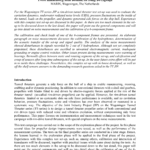
René Bosman Yvette Klinkenberg, Jie Dang; Ligtelijn, Do
Advanced measurements of rim-driven tunnel thrusters --The Wageningen TT-series JIP-- Conference
The 5th international conference on advanced model measurements technology (AMT '17) 11/13-10-2017, 2017.
Abstract | Links | BibTeX | Tags: cavitation dynamics, the Wageningen TT-series JIP
@conference{Klinkenberg2017,
title = {Advanced measurements of rim-driven tunnel thrusters --The Wageningen TT-series JIP--},
author = {Yvette Klinkenberg, René Bosman, Jie Dang and Do Ligtelijn},
url = {http://www.marin.nl/web/Publications/Publication-items/Advanced-measurements-of-rimdriven-tunnel-thrusters-The-Wageningen-TTseries-JIP.htm},
year = {2017},
date = {2017-10-11},
booktitle = {The 5th international conference on advanced model measurements technology (AMT '17) 11/13-10-2017},
abstract = {For the Wageningen TT-series JIP a rim-driven tunnel thruster test set-up was used to evaluate the cavitation dynamics, underwater radiated noise levels (URN), pressure fluctuations on the inside of the tunnel, loads on the propeller, and dynamic generated side forces on the ship hull. Experiences with this complex test set-up are discussed in this paper. As there are too much elements in the set-up to be discussed down to the last detail, this paper will point out the general components and will go into detail on noise measurements and the calibration of a 6-component frame.
The calibration and check loads of one of the 6-component frames are presented. An elaborate paragraph on noise measurements discusses the calibration of the hydrophones, determination of the acoustic transfer of the set-up and signal quality. The analysis of the noise measurements showed disturbances in signals recorded by 2 out of 3 hydrophones. Although not yet completely pinpointed, these disturbances are ascribed to unwanted electromagnetic current, inadequate grounding or engine control switches. Other issues present during measurements were warming of bearings, Bernoulli effects between static and rotating segments of the set-up, and calcification and creep of sensors after long time submergence of the set-up. In the near future extra effort will be put in to tackle these challenges. Nevertheless, this complex set-up with in-house developed, as well as off the shelf sensors answers to the demanding research questions asked in the TT JIP.},
keywords = {cavitation dynamics, the Wageningen TT-series JIP},
pubstate = {published},
tppubtype = {conference}
}
The calibration and check loads of one of the 6-component frames are presented. An elaborate paragraph on noise measurements discusses the calibration of the hydrophones, determination of the acoustic transfer of the set-up and signal quality. The analysis of the noise measurements showed disturbances in signals recorded by 2 out of 3 hydrophones. Although not yet completely pinpointed, these disturbances are ascribed to unwanted electromagnetic current, inadequate grounding or engine control switches. Other issues present during measurements were warming of bearings, Bernoulli effects between static and rotating segments of the set-up, and calcification and creep of sensors after long time submergence of the set-up. In the near future extra effort will be put in to tackle these challenges. Nevertheless, this complex set-up with in-house developed, as well as off the shelf sensors answers to the demanding research questions asked in the TT JIP.
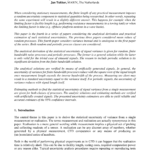
Brouwer, Joris; Tukker, Jan
Random uncertainty of variance of finite length measurement signals Conference
The 5th international conference on advanced model measurements technology (AMT '17) 11/13-10-2017, 2017.
Abstract | Links | BibTeX | Tags: stationary measurements, statistical uncertainties
@conference{Brouwer2017,
title = {Random uncertainty of variance of finite length measurement signals},
author = {Joris Brouwer and Jan Tukker},
url = {http://www.marin.nl/web/Publications/Publication-items/Random-uncertainty-of-variance-of-finite-length-measurement-signals.htm},
year = {2017},
date = {2017-10-11},
booktitle = {The 5th international conference on advanced model measurements technology (AMT '17) 11/13-10-2017},
abstract = {When considering stationary measurements, the finite length of any practical measurement imposes a random uncertainty component to statistical quantities being researched. In other words, repeating the same experiment will result in a slightly different answer. This happens for example when the limiting factor is facility length (e.g. performing resistance measurements in a towing tank) or when the limiting factor is time (e.g. offshore platform motions in a wave basin).
This paper is the fourth in a series of papers considering the analytical derivation and practical estimation of such statistical uncertainties. The previous three papers considered mean values of
random processes. This fourth paper considers variance instead and is analogous to the first paper of the series. Both random and periodic process classes are considered. The analytical derivation of the statistical uncertainty of signal variance is given for random, finite bandwidth noise processes and periodic processes. The former is a general solution while the latter is only valid for the trivial case of sinusoid signals. The reason to include periodic solution is its significant deviation from the finite bandwidth solution. The analytical solutions are verified by means of artificially generated signals. In general, the uncertainty of variance for finite bandwidth processes reduce with the square root of the signal length once measurement length exceeds the inverse bandwidth of the process. Measuring too short may result in a standard uncertainty equal to the variance itself. For periodic signals, the uncertainty of variance reduces with signal length itself. Estimating methods to find the statistical uncertainty of signal variance from a single measurement are given for both classes of processes. The analytic solutions and estimating methods are verified with artificially created signals. The presented uncertainty estimators are able to yield reliable and accurate estimates of the 95% confidence intervals.},
keywords = {stationary measurements, statistical uncertainties},
pubstate = {published},
tppubtype = {conference}
}
This paper is the fourth in a series of papers considering the analytical derivation and practical estimation of such statistical uncertainties. The previous three papers considered mean values of
random processes. This fourth paper considers variance instead and is analogous to the first paper of the series. Both random and periodic process classes are considered. The analytical derivation of the statistical uncertainty of signal variance is given for random, finite bandwidth noise processes and periodic processes. The former is a general solution while the latter is only valid for the trivial case of sinusoid signals. The reason to include periodic solution is its significant deviation from the finite bandwidth solution. The analytical solutions are verified by means of artificially generated signals. In general, the uncertainty of variance for finite bandwidth processes reduce with the square root of the signal length once measurement length exceeds the inverse bandwidth of the process. Measuring too short may result in a standard uncertainty equal to the variance itself. For periodic signals, the uncertainty of variance reduces with signal length itself. Estimating methods to find the statistical uncertainty of signal variance from a single measurement are given for both classes of processes. The analytic solutions and estimating methods are verified with artificially created signals. The presented uncertainty estimators are able to yield reliable and accurate estimates of the 95% confidence intervals.
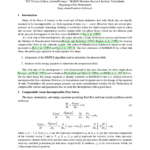
H. Abreu, Eça; Klaij, C. M.
20th Numerical Towing Tank Symposium (NuTTS), Wageningen, The Netherlands, 2017.
Abstract | Links | BibTeX | Tags: Code verification, Manufactured solutions, ReFRESCO
@conference{Abreu2017,
title = {Code Verification Exercise of a Navier-Stokes Solver for Compressible Flows in the Laminar and Subsonic Regimes},
author = {Abreu, H., Eça, L., and Klaij, C.M.},
url = {http://www.marin.nl/web/Publications/Publication-items/Code-Verification-Exercise-of-a-NavierStokes-Solver-for-Compressible-Flows-in-the-Laminar-and-Subsonic-Regimes.htm},
year = {2017},
date = {2017-10-03},
booktitle = {20th Numerical Towing Tank Symposium (NuTTS), Wageningen, The Netherlands},
abstract = {Many of the flows of interest to the naval and offshore industries deal with fluids that are usually assumed to be incompressible. However, there are several phenomena, as for example slamming, sloshing or cavitation where the fluid compressibility must be taken into account. All these applications involve compressible two-phase flows, which are the ultimate goal of the present development of the flow solver ReFRESCO.
As a first step of this development, this paper presents a Code Verification exercise performed with the Method of Manufactured Solutions, for laminar compressible flows in the subsonic regime. This first extension of ReFRESCO for a fluid that obeys the perfect gas equation of state requires two steps: 1. Adaptation of the SIMPLE algorithm used to determine the pressure field. 2. Solution of the energy equation to determine the temperature field.
This first step of the development is well documented in the open literature for both single phase and multiphase flows. On the other hand, the energy equation is already available in ReFRESCO but it is seldom solved in incompressible flow solutions. However, its formulation must be updated due to the change of the equation of state. Nonetheless, the present paper presents one more manufactured solution for the Verification of compressible solvers and guarantees that we start this development with a good basis.},
keywords = {Code verification, Manufactured solutions, ReFRESCO},
pubstate = {published},
tppubtype = {conference}
}
As a first step of this development, this paper presents a Code Verification exercise performed with the Method of Manufactured Solutions, for laminar compressible flows in the subsonic regime. This first extension of ReFRESCO for a fluid that obeys the perfect gas equation of state requires two steps: 1. Adaptation of the SIMPLE algorithm used to determine the pressure field. 2. Solution of the energy equation to determine the temperature field.
This first step of the development is well documented in the open literature for both single phase and multiphase flows. On the other hand, the energy equation is already available in ReFRESCO but it is seldom solved in incompressible flow solutions. However, its formulation must be updated due to the change of the equation of state. Nonetheless, the present paper presents one more manufactured solution for the Verification of compressible solvers and guarantees that we start this development with a good basis.
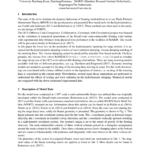
S. Burmester, Gueydon; El Moctar, B
Surge Decay Simulations of a Semi-Submersible Floating Offshore Wind Turbine Conference
20th Numerical Towing Tank Symposium (NuTTS), Wageningen, The Netherlands, 2017.
Abstract | Links | BibTeX | Tags: DeepCwind, OC5, semi-submersible floating wind turbine, validation of numerical simulations
@conference{Burmester2017,
title = {Surge Decay Simulations of a Semi-Submersible Floating Offshore Wind Turbine},
author = {Burmester, S., Gueydon, S., Vaz, G. and El Moctar, B},
url = {http://www.marin.nl/web/Publications/Publication-items/Surge-Decay-Simulations-of-a-SemiSubmersible-Floating-Offshore-Wind-Turbine.htm},
year = {2017},
date = {2017-10-03},
booktitle = {20th Numerical Towing Tank Symposium (NuTTS), Wageningen, The Netherlands},
abstract = {The OC5 (Offshore Code Comparison, Collaboration, Continued, with Correlation) project was focused on the validation of numerical simulations of the DeepCwind semi-submersible floating wind turbine with experimental data obtained from physical tests performed at the facilities of MARIN. In this paper the focus lies on the prediction of the hydrodynamic damping for surge motion. It is assumed that the hydrodynamic damping consists of wave radiation damping, viscous damping and drag of the mooring lines. The viscous damping cannot be predicted by potential flow based methods. On these grounds, the viscous flow solver ReFRESCO is used to simulate the surge decay test of the OC5 semi-submersible floating wind turbine. There are many mooring models available with lots of different properties. Dynamic mooring models are needed to account for the drag of the mooring lines moving in water. For this work the moorings are considered with a linear stiffness matrix in the equations of motion, i.e. no drag of the mooring lines is considered in the current study. Nevertheless, several surge decay simulations are performed to understand the effects of scaling and wave radiation on the hydrodynamic damping. Numerical results are compared with the above mentioned experimental data.},
keywords = {DeepCwind, OC5, semi-submersible floating wind turbine, validation of numerical simulations},
pubstate = {published},
tppubtype = {conference}
}
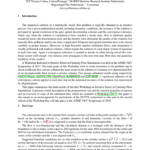
L. Eça, Vaz; Hoekstra, M.
Iterative Errors in Unsteady Flow Simulations: Are they Really Negligible? Conference
20th Numerical Towing Tank Symposium (NuTTS), Wageningen, The Netherlands, 2017.
Abstract | Links | BibTeX | Tags: iterative error, NUTTS symposium, Unsteady Flow Simulations
@conference{Eça2017,
title = {Iterative Errors in Unsteady Flow Simulations: Are they Really Negligible?},
author = {Eça, L., Vaz, G. and Hoekstra, M.},
url = {http://www.marin.nl/web/Publications/Publication-items/Iterative-Errors-in-Unsteady-Flow-Simulations-Are-they-Really-Negligible.htm},
year = {2017},
date = {2017-10-03},
booktitle = {20th Numerical Towing Tank Symposium (NuTTS), Wageningen, The Netherlands},
abstract = {The numerical solution of a statistically steady flow problem is typically obtained in an iterative process. For a given mathematical model, including boundary conditions, the accuracy of the solution is governed by spatial resolution of the grid, spatial discretisation schemes and the convergence tolerance, which says when the solution is considered to have reached a steady state. Next to hardware quality (round-off error), the discretisation error and the iterative error determine the quality of the solution. For unsteady flow problems matters are more complicated. Temporal and spatial resolution have to be chosen carefully in proper balance. Moreover, in high Reynolds number (turbulent) flows, time integration is usually performed with implicit schemes, which require the solution of a non-linear system of equations at each time step. Again a convergence tolerance is needed to decide on when having solved this nonlinear system well enough. Any iterative error propagates to the next time step. How does one guarantee reliability of the results?
This paper summarizes the main results of this first Workshop on Iterative Errors in Unsteady Flow Simulations. It presents a brief description of the proposed test case and the selected quantities of interest and an overview of some of the submitted data. The paper is also meant as an encouragement for participants of the NUTTS symposium to take part in the second edition of the Workshop that will take place at the ASME V&V Symposium of 2018.},
keywords = {iterative error, NUTTS symposium, Unsteady Flow Simulations},
pubstate = {published},
tppubtype = {conference}
}
This paper summarizes the main results of this first Workshop on Iterative Errors in Unsteady Flow Simulations. It presents a brief description of the proposed test case and the selected quantities of interest and an overview of some of the submitted data. The paper is also meant as an encouragement for participants of the NUTTS symposium to take part in the second edition of the Workshop that will take place at the ASME V&V Symposium of 2018.
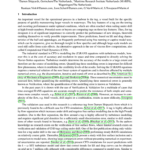
B. Vink, Schot; Toxopeus, S. L.
A Verification and Validation Study of CFD Simulations for the Flow Around A Tug Conference
20th Numerical Towing Tank Symposium (NuTTS), Wageningen, The Netherlands, 2017.
Abstract | Links | BibTeX | Tags: CFD, tugs, verification and validation
@conference{Vink2017,
title = {A Verification and Validation Study of CFD Simulations for the Flow Around A Tug},
author = {Vink, B., Schot, J., Vaz, G. and Toxopeus, S.L.},
url = {http://www.marin.nl/web/Publications/Publication-items/A-Verification-and-Validation-Study-of-CFD-Simulations-for-the-Flow-Around-A-Tug.htm},
year = {2017},
date = {2017-10-03},
booktitle = {20th Numerical Towing Tank Symposium (NuTTS), Wageningen, The Netherlands},
abstract = {An important vessel for the operational process in a harbour is the tug, a vessel built for the specific purpose of quickly manoeuvring larger vessels in waterways. The key features of a tug are the towing and escorting performances under optimal conditions, which are often reached when sailing under drift at high Froude numbers. Potential users or buyers are comparing tugs on these key features. Thus, for tug designers it is of significant importance to correctly predict the performance of new designs, therewith enabling themselves to verify possible improvements. These predictions, based on lift and drag characteristics of the hull and appendages, are frequently performed using free running or captive model tests, which can be expensive, give no thorough insight in flow specifics and although large-scale models are used still suffer from scale effects. An alternative approach is the use of viscous flow computations, also called Computational Fluid Dynamics (CFD).
This present work will initially estimate the experimental uncertainties from captive model tests to obtain correct validation material. Thereafter a verification and validation exercise of free surface simulations with the KSKL turbulence model and a drift angle of 15 deg will be presented. These are followed by a turbulence sensitivity study of the KSKL, SST, EARSM and DDES turbulence model and finally simulations at other drift angles with the KSKL turbulence will be presented.},
keywords = {CFD, tugs, verification and validation},
pubstate = {published},
tppubtype = {conference}
}
This present work will initially estimate the experimental uncertainties from captive model tests to obtain correct validation material. Thereafter a verification and validation exercise of free surface simulations with the KSKL turbulence model and a drift angle of 15 deg will be presented. These are followed by a turbulence sensitivity study of the KSKL, SST, EARSM and DDES turbulence model and finally simulations at other drift angles with the KSKL turbulence will be presented.
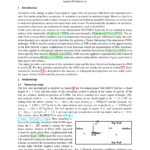
C. Negrato, Van Terwisga; Bensow, R.
Analysis of Hydrofoil Cavitation using Proper Orthogonal Decomposition Conference
20th Numerical Towing Tank Symposium (NuTTS), Wageningen, The Netherlands, 2017.
Abstract | Links | BibTeX | Tags: Hydrofoil Cavitation, NACA0015 hydrofoil, Proper Orthogonal Decomposition method
@conference{Negrato2017b,
title = {Analysis of Hydrofoil Cavitation using Proper Orthogonal Decomposition},
author = {Negrato, C., Van Terwisga, T.J.C. and Bensow, R.},
url = {http://www.marin.nl/web/Publications/Publication-items/Analysis-of-Hydrofoil-Cavitation-using-Proper-Orthogonal-Decomposition.htm},
year = {2017},
date = {2017-10-03},
booktitle = {20th Numerical Towing Tank Symposium (NuTTS), Wageningen, The Netherlands},
abstract = {Cavitation is the change of phase from liquid to vapor when the pressure falls below the saturation pressure. For marine propellers, occurrence of cavitation is accepted on modern designs. However, there is a need to keep cavitation under control, because its extent can influence propeller efficiency, as well as lead to undesired phenomena such as increased noise and erosion. To understand the dynamics of cavitation, researchers often focus on cavitation on simpler geometries, such as hydrofoils. In this work, the test case consists on a two dimensional NACA0015 hydrofoil. The results from a viscous flow simulation are considered here; the scope is to gain additional insight into cavitation dynamics in a regime of cavity shedding, by applying a Proper Orthogonal Decomposition (POD) technique. POD is used for analysis of experimental data or CFD results and relies on the approximation of the flow field by a linear combination of basis functions which are representative of flow structures.
This paper provides a description of the numerical setup and the basic theoretical background for POD and shows the outcome of orthogonal decomposition for two scalar fields: the vapor volume fraction and the pressure coefficient.},
keywords = {Hydrofoil Cavitation, NACA0015 hydrofoil, Proper Orthogonal Decomposition method},
pubstate = {published},
tppubtype = {conference}
}
This paper provides a description of the numerical setup and the basic theoretical background for POD and shows the outcome of orthogonal decomposition for two scalar fields: the vapor volume fraction and the pressure coefficient.

Rotte, G.; Kerkvliet, M.; Van Terwisga, T. J. C.
On the Turbulence Modelling for an Air Cavity Interface Conference
20th Numerical Towing Tank Symposium (NuTTS), Wageningen, The Netherlands, 2017.
Abstract | Links | BibTeX | Tags: air lubrication techniques, Multiphase CFD methods
@conference{Rotte2017,
title = {On the Turbulence Modelling for an Air Cavity Interface},
author = {Rotte, G. and Kerkvliet, M. and Van Terwisga, T.J.C.},
url = {http://www.marin.nl/web/Publications/Publication-items/On-the-Turbulence-Modelling-for-an-Air-Cavity-Interface.htm},
year = {2017},
date = {2017-10-03},
booktitle = {20th Numerical Towing Tank Symposium (NuTTS), Wageningen, The Netherlands},
abstract = {The use of air lubrication techniques can significantly reduce a ship’s fuel consumption. One of the most promising techniques applicable to ships is the external air cavity technique. An external cavity is created beneath the ship’s hull with the help of a cavitator, which is located directly upstream of an air injection point (figure 1a). The cavitator is extended in the span-wise direction and typically has a rectangular or triangular cross section. It is used to separate the mean water flow from the hull, thereby providing a stable air layer. Air cavity applications are claimed to lead to propulsive power reduction percentages of 10-20% by reducing the ship’s frictional drag. However, a complete understanding of the influence that the ship’s hull form has on the relevant twophase flow physics and thereby also on the length and stability of the air cavities is still lacking. This inability to predict the air cavity characteristics hampers the application of air cavity techniques in the shipping industry. Multiphase CFD methods can help us to gain a better understanding of the relevant physics.
This article aims to link the physical modelling of the relevant phenomena to their numerical modelling, with an emphasis on the modelling of the re-entrant jet mechanism with a RaNS turbulence model. The article is based on the available literature in the public domain and on knowledge gained from research projects carried out at Delft University of Technology and at the Maritime Research Institute Netherlands (MARIN).},
keywords = {air lubrication techniques, Multiphase CFD methods},
pubstate = {published},
tppubtype = {conference}
}
This article aims to link the physical modelling of the relevant phenomena to their numerical modelling, with an emphasis on the modelling of the re-entrant jet mechanism with a RaNS turbulence model. The article is based on the available literature in the public domain and on knowledge gained from research projects carried out at Delft University of Technology and at the Maritime Research Institute Netherlands (MARIN).
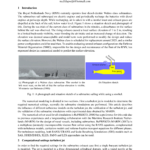
M. Klapwijk, Rotte; Van Terwisga, T.
Modelling of the Plume of a Submerged Exhaust System Conference
20th Numerical Towing Tank Symposium (NuTTS), Wageningen, The Netherlands, 2017.
Abstract | Links | BibTeX | Tags: Exhaust System, numerical modelling, RNN, submarines
@conference{Klapwijk2017,
title = {Modelling of the Plume of a Submerged Exhaust System},
author = {Klapwijk, M., Rotte, G., Kerkvliet, M. and Van Terwisga, T.},
url = {http://www.marin.nl/web/Publications/Publication-items/Modelling-of-the-Plume-of-a-Submerged-Exhaust-System.htm},
year = {2017},
date = {2017-10-03},
booktitle = {20th Numerical Towing Tank Symposium (NuTTS), Wageningen, The Netherlands},
abstract = {The Royal Netherlands Navy (RNN) currently operates four diesel-electric Walrus class submarines. The submarines sail submerged on electric engines and periodically recharge the batteries with diesel engines at periscope depth. While recharging, air is taken in with a snorkel mast and exhaust gases are dispelled at the back of the sail, below water level.
To enable evaluating several exhaust configurations the Defence Material Organisation (DMO), responsible for the design and maintenance of the fleet of the RNN, has expressed desire in a numerical model to predict the surface elevation.
The numerical modelling is divided in two sections. First a turbulent jet is modelled to determine the required numerical settings, secondly the submarine simulations are performed. This article describes the influence of different turbulence models on the turbulent jet, the verification of the turbulent jet, and the validation of the submarine simulations with experimental data obtained by MARIN.},
keywords = {Exhaust System, numerical modelling, RNN, submarines},
pubstate = {published},
tppubtype = {conference}
}
To enable evaluating several exhaust configurations the Defence Material Organisation (DMO), responsible for the design and maintenance of the fleet of the RNN, has expressed desire in a numerical model to predict the surface elevation.
The numerical modelling is divided in two sections. First a turbulent jet is modelled to determine the required numerical settings, secondly the submarine simulations are performed. This article describes the influence of different turbulence models on the turbulent jet, the verification of the turbulent jet, and the validation of the submarine simulations with experimental data obtained by MARIN.
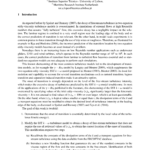
R. Lopes, Eça; Vaz, G.
On the Decay of Freestream Turbulence Predicted by Two-equation Eddy-viscosity Models Conference
20th Numerical Towing Tank Symposium (NuTTS), Wageningen, The Netherlands, 2017.
Abstract | Links | BibTeX | Tags: decay of freestream turbulence, transitional flows, two-equation eddy-viscosity SST model
@conference{Lopes2017,
title = {On the Decay of Freestream Turbulence Predicted by Two-equation Eddy-viscosity Models},
author = {Lopes, R., Eça, L. and Vaz, G.},
url = {http://www.marin.nl/web/Publications/Publication-items/On-the-Decay-of-Freestream-Turbulence-Predicted-by-Twoequation-Eddyviscosity-Models.htm},
year = {2017},
date = {2017-10-03},
booktitle = {20th Numerical Towing Tank Symposium (NuTTS), Wageningen, The Netherlands},
abstract = {As reported before by Spalart and Rumsey, the decay of freestream turbulence in two-equation eddy-viscosity turbulence models is overestimated. In simulations of external flows at high Reynolds numbers that assume "fully turbulent" flow, this excessive decay has a negligible impact on the solution. The laminar regime is confined to a very small region near the leading edge of the body and so the correct prediction of transition is not relevant. On the other hand, in model scale experiments it is common practice to force transition through the use of trip wires or roughness. Therefore, the incorrect prediction of the transition location by two-equation eddy-viscosity models becomes an asset instead of a problem.
This known shortcoming of the most common turbulence models led to the development of transition models, which supplement the two-equation eddy-viscosity SST model. Its local formulation and capability to account for several transition mechanisms such as natural transition, bypass transition and separation-induced transition make it an attractive option. The onset of transition is strongly dependent on the level of the free-stream turbulence intensity, which makes the excessive decay of turbulence predicted by the SST model troublesome.
In this paper we present the first step of this development that is performed for the flow over a flat plate, for which there are experimental data available for transitional flows with different levels of freestream turbulence in the ERCOFTAC Classic Database.},
keywords = {decay of freestream turbulence, transitional flows, two-equation eddy-viscosity SST model},
pubstate = {published},
tppubtype = {conference}
}
This known shortcoming of the most common turbulence models led to the development of transition models, which supplement the two-equation eddy-viscosity SST model. Its local formulation and capability to account for several transition mechanisms such as natural transition, bypass transition and separation-induced transition make it an attractive option. The onset of transition is strongly dependent on the level of the free-stream turbulence intensity, which makes the excessive decay of turbulence predicted by the SST model troublesome.
In this paper we present the first step of this development that is performed for the flow over a flat plate, for which there are experimental data available for transitional flows with different levels of freestream turbulence in the ERCOFTAC Classic Database.
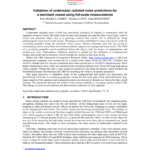
Frans Hendrik Lafeber, Thomas Lloyd; Bosschers, Johan
Inter.Noise Hongkong 27-30 August, no. ID682, 2017.
Abstract | Links | BibTeX | Tags: cavitating propellers, underwater radiated noise, validation study
@conference{Lafeber2017b,
title = {Validation of underwater radiated noise predictions for a merchant vessel using full-scale measurements},
author = {Frans Hendrik Lafeber, Thomas Lloyd and Johan Bosschers},
url = {http://www.marin.nl/web/Publications/Publication-items/Validation-of-underwater-radiated-noise-predictions-for-a-merchant-vessel-using-fullscale-measurements.htm},
year = {2017},
date = {2017-08-27},
booktitle = {Inter.Noise Hongkong 27-30 August},
number = {ID682},
abstract = {Underwater radiated noise (URN) was previously primarily of interest in connection with the signature of naval vessels. Recently it has become increasingly relevant for other vessel types, such as cruise and merchant ships, due to a growing concern that marine life is affected by rising anthropogenic noise levels in the oceans. Shipping is a main contributor to those noise levels, with the cavitating propeller being the dominant noise source. Marine mammals and fish use sound to communicate and to sense their environment and this requires low background noise levels. The URN of a cavitating propeller can be predicted before the ship is built by means of computations and model-scale tests. High-quality validation material is needed for the validation of computational models and model test procedures, which include the scaling of the noise levels. Within the CRS framework (Cooperative Research Ships, http://www.crships.org/) a full-scale measurement campaign was carried out on a single-screw cargo vessel by DNV-GL, DAMEN and MARIN. Model tests for several conditions have been carried out in MARIN’s Depressurized Wave Basin. During these tests, URN was measured and cavitation patterns were observed using high-speed video cameras. Within the CRS a semi-empirical model has also been developed, which predicts the broadband pressure fluctuations and URN of cavitating tip vortices on marine propellers. This paper discusses a validation study of the computational and model test procedures for determining URN due to cavitating propellers, using the full-scale data of the aforementioned ship. Some aspects of the analysis and scaling procedures are discussed. Results are shown for three pitch settings. The agreement between the results of the various methods is very good; mostly within 3 dB. The change in noise levels between the three tested conditions is well captured.},
keywords = {cavitating propellers, underwater radiated noise, validation study},
pubstate = {published},
tppubtype = {conference}
}
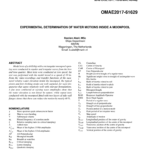
Abeil, Bastien
Experimental determination of water motions inside a moonpool Conference
Proceedings of the ASME 2017 36th International Conference on Ocean, Offshore and Arctic Engineering OMAE2017 , 2017.
Abstract | Links | BibTeX | Tags: damping, drillship, moonpool, SMB
@conference{Abeil2017,
title = {Experimental determination of water motions inside a moonpool},
author = {Bastien Abeil },
url = {http://www.marin.nl/web/Publications/Publication-items/Experimental-determination-of-water-motions-inside-a-moonpool.htm},
year = {2017},
date = {2017-06-25},
booktitle = {Proceedings of the ASME 2017 36th International Conference on Ocean, Offshore and Arctic Engineering OMAE2017
},
abstract = {The substantial water motions that can occur inside a moonpool when a ship is operating in a formed sea represent a critical issue for operators, as they imply an interruption of subsea activities (e.g. delay in ROV deployment) or even a threat to the survival of the equipment placed inside or around the moonpool (e.g. riser connected to a BOP). In a perspective of reducing downtime caused by moonpool inactivity, substantial effort has been made over the past year to better understand the circumstances of such water dynamics and devise mitigation measures. Works of among others Fukuda [1] or Molin [2] show that the moonpool motions can be described as either piston mode, in other words a vertical displacement of the water column, or as horizontal sloshing modes, which natural frequencies can be approximated by closed-form expressions involving moonpool geometry and draught. The effect of damping devices, such as side wall flanges, has been widely investigated, notable publications include those of Fukuda [1] and Aalbers [3].
State-of-the-art prediction of moonpool flows has undergone some significant changes over the last years. Away from analytical formulations (Aalbers [3]) and potential flow, the industry is nowadays moving towards the more advanced viscous flow methods, which allow a more complete description of the flow phenomena. Scale model tests are still conducted for numerical validation and final design verification.
A glance at the available litterature concerning moonpool flows learns that fully disclosed, well-documented experimental work is unfortunately little available, albeit crucial for numerical method validation. The present paper attemps to fill in this gap by presenting and discussing in detail the preparations and results of a model test campaign performed on a generic drillship model. Because all tests were conducted in waves, most of them at zero speed, the campaign focused on the measurement of water motions in typical operational conditions.
The following sections provide a complete description of the scale model, including body plan and loading condition, a presentation of the testing facility, testing set-up and measuring equipment and finally a detailed description and discussion of the test results.},
keywords = {damping, drillship, moonpool, SMB},
pubstate = {published},
tppubtype = {conference}
}
State-of-the-art prediction of moonpool flows has undergone some significant changes over the last years. Away from analytical formulations (Aalbers [3]) and potential flow, the industry is nowadays moving towards the more advanced viscous flow methods, which allow a more complete description of the flow phenomena. Scale model tests are still conducted for numerical validation and final design verification.
A glance at the available litterature concerning moonpool flows learns that fully disclosed, well-documented experimental work is unfortunately little available, albeit crucial for numerical method validation. The present paper attemps to fill in this gap by presenting and discussing in detail the preparations and results of a model test campaign performed on a generic drillship model. Because all tests were conducted in waves, most of them at zero speed, the campaign focused on the measurement of water motions in typical operational conditions.
The following sections provide a complete description of the scale model, including body plan and loading condition, a presentation of the testing facility, testing set-up and measuring equipment and finally a detailed description and discussion of the test results.

A. Maximiano, Vaz; Scharnke, J.
CFD Verification and Validation Study for a Captive Bullet Entry in Calm Water Conference
OMAE ASME 36th International Conference on Ocean, Offshore and Arctic Engineering, Trondheim, Norway, 2017.
Abstract | Links | BibTeX | Tags: CFD, ReFRESCO, verification and validation
@conference{Maximiano2017,
title = {CFD Verification and Validation Study for a Captive Bullet Entry in Calm Water},
author = {Maximiano, A., Vaz, G. and Scharnke, J.},
url = {http://www.marin.nl/web/Publications/Publication-items/CFD-Verification-and-Validation-Study-for-a-Captive-Bullet-Entry-in-Calm-Water.htm},
year = {2017},
date = {2017-06-25},
booktitle = {OMAE ASME 36th International Conference on Ocean, Offshore and Arctic Engineering, Trondheim, Norway},
pages = {OMAE2017-61666},
abstract = {As a step towards complex impact loads cases, e.g. lifeboat drop tests or ship/platform slamming in waves, a verification and validation (V&V) study is carried out with an open-usage community based CFD code ReFRESCO for a simple impact load test case: a captive axisymmetric generic lifeboat shape (bullet) that penetrates the water surface at a constant velocity and angle of attack. The quantities of interest are the body fixed longitudinal force FX, vertical force FZ, and pitch moment MYY.
The influence of the iterative convergence level, domain size and free surface modelling are investigated. Seven different grids and four time steps were used to assess the grid and time step sensitivity, in a total of 28 calculations. For the tested grids and time steps it was found that the results are more sensitive to the grid resolution than to the time step. The pressure distribution on the hull is correlated with the trends observed in the loads, and the relation between between relative and static pressure is found to be important for the calculated loads. An experimental test campaign was previously carried out by MARIN, and its results are used to validate the simulations performed. A very good match between experiments and simulations is found.
A V&V study is performed for the quantities of interest at nine different time instants covering the impact phase. The numerical uncertainties are obtained from a solution verification procedure [1]. The experimental uncertainties are estimated, and a validation exercise carried out according to the ASME standards [2]. The outcome of the validation exercise is an estimated 95% confidence interval for the modelling error, M. For FX the modelling error is below 15 N, for 8 out of 9 time instants. For FZ the modelling error is below 14 N, except at the time instants where, due to vibrations in the experimental setup, a larger value (up to 23 N) is found. For MYY the modelling error is under 5Nm. These results provide confidence in ReFRESCO for the simulation of free surface impact flows.},
keywords = {CFD, ReFRESCO, verification and validation},
pubstate = {published},
tppubtype = {conference}
}
The influence of the iterative convergence level, domain size and free surface modelling are investigated. Seven different grids and four time steps were used to assess the grid and time step sensitivity, in a total of 28 calculations. For the tested grids and time steps it was found that the results are more sensitive to the grid resolution than to the time step. The pressure distribution on the hull is correlated with the trends observed in the loads, and the relation between between relative and static pressure is found to be important for the calculated loads. An experimental test campaign was previously carried out by MARIN, and its results are used to validate the simulations performed. A very good match between experiments and simulations is found.
A V&V study is performed for the quantities of interest at nine different time instants covering the impact phase. The numerical uncertainties are obtained from a solution verification procedure [1]. The experimental uncertainties are estimated, and a validation exercise carried out according to the ASME standards [2]. The outcome of the validation exercise is an estimated 95% confidence interval for the modelling error, M. For FX the modelling error is below 15 N, for 8 out of 9 time instants. For FZ the modelling error is below 14 N, except at the time instants where, due to vibrations in the experimental setup, a larger value (up to 23 N) is found. For MYY the modelling error is under 5Nm. These results provide confidence in ReFRESCO for the simulation of free surface impact flows.
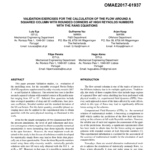
L. Eça, Vaz; Abreu, H.
OMAE ASME 36th International Conference on Ocean, Offshore and Arctic Engineering, Trondheim, Norway, 2017.
Abstract | Links | BibTeX | Tags: Calculation, RANS Equations, Validation studies
@conference{Eça2017b,
title = {Validation Exercises for the Calculation of the Flow Around a Squared Column With Rounded Corners at High Reynolds Numbers With the RANS Equations},
author = {Eça, L., Vaz, G., Koop, A.K., Pereira, F. and Abreu, H.},
url = {http://www.marin.nl/web/Publications/Publication-items/Validation-Exercises-for-the-Calculation-of-the-Flow-Around-a-Squared-Column-With-Rounded-Corners-at-High-Reynolds-Numbers-With-the-RANS-Equations.htm},
year = {2017},
date = {2017-06-25},
booktitle = {OMAE ASME 36th International Conference on Ocean, Offshore and Arctic Engineering, Trondheim, Norway},
pages = {OMAE2017-61937},
abstract = {This paper presents Validation studies, i.e. evaluation of the modelling error, for the ensemble averaged Navier-Stokes (RANS) equations supplemented by eddy-viscosity models (SST k-omega and Spalart & Allmaras). The selected test case is the flow around a squared column with rounded corners at Reynolds number ranging from 1E5 to 1E7. Selected flow quantities include time-averaged quantities of drag and lift coefficients, base pressure coefficient, Strouhal number and the standard deviation of the lift coefficient. For this latter quantity, ensemble (phase) averaging must also be applied to the experimental data to obtain quantities with the same physical meaning, as illustrated in this work.
Even for the simple assumption of two-dimensional flow of the present simulations, the level of grid refinement and iterative convergence criteria required to obtain acceptable numerical uncertainties is more demanding than those typically observed in the open literature. However, the most important result obtained in this study is that the use of turbulence models developed for statistically steady flows may lead to flow fields that physically are at least questionable. From the three Reynolds numbers tested using three eddy-viscosity models, statistically periodic solutions with zero lift were only obtained with the SST k-omega at Re = 1E5. However, in that case, it is possible to numerically (including statistical, iterative and discretization errors) converge two different flow fields for the same space boundary conditions, but different solution strategies (start up of the vortex shedding).},
keywords = {Calculation, RANS Equations, Validation studies},
pubstate = {published},
tppubtype = {conference}
}
Even for the simple assumption of two-dimensional flow of the present simulations, the level of grid refinement and iterative convergence criteria required to obtain acceptable numerical uncertainties is more demanding than those typically observed in the open literature. However, the most important result obtained in this study is that the use of turbulence models developed for statistically steady flows may lead to flow fields that physically are at least questionable. From the three Reynolds numbers tested using three eddy-viscosity models, statistically periodic solutions with zero lift were only obtained with the SST k-omega at Re = 1E5. However, in that case, it is possible to numerically (including statistical, iterative and discretization errors) converge two different flow fields for the same space boundary conditions, but different solution strategies (start up of the vortex shedding).
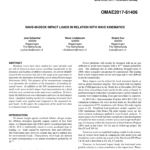
Réne Lindeboom Jule Scharnke, Bulent Duz
Wave-in-Deck Impact Loads in Relation with Wave Kinematics Conference
OMAE ASME 36th International Conference on Ocean, Offshore and Arctic Engineering, Trondheim, Norway, 2017, 2017.
Abstract | Links | BibTeX | Tags: Breaking waves, offshore structures, Particle Image Velocimetry (PIV)
@conference{Scharnke2017,
title = {Wave-in-Deck Impact Loads in Relation with Wave Kinematics},
author = {Jule Scharnke, Réne Lindeboom, Bulent Duz},
url = {http://www.marin.nl/web/Publications/Publication-items/WaveinDeck-Impact-Loads-in-Relation-with-Wave-Kinematics.htm},
year = {2017},
date = {2017-06-25},
booktitle = {OMAE ASME 36th International Conference on Ocean, Offshore and Arctic Engineering, Trondheim, Norway, 2017},
pages = {OMAE61406},
abstract = {Breaking waves have been studied for many decades and are still of interest as these waves contribute significantly to the dynamics and loading of offshore structures. In current MARIN research this awareness has led to the setup of an experiment to determine the kinematics of breaking waves using Particle Image Velocimetry (PIV). The purpose of the measurement campaign is to determine the evolution of the kinematics of breaking focussed waves. In addition to the PIV measurements in waves, small scale wave-in-deck impact load measurements on a fixed deck box were carried out in the same wave conditions. To investigate the link between wave kinematics and wave-in-deck impact loads, simplified loading models for estimating horizontal deck impact loads were applied and compared to the measured impact loads. In this paper, the comparison of the model test data to estimated loads is presented.},
keywords = {Breaking waves, offshore structures, Particle Image Velocimetry (PIV)},
pubstate = {published},
tppubtype = {conference}
}

Bosschers, Johan
Fifth International Symposium on Marine Propulsors smp’17, 2017.
Abstract | Links | BibTeX | Tags: cavitation, hull pressures, propeller, tip vortex, underwater radiated noise
@conference{Bosschers2017,
title = {A Semi-Empirical Method to Predict Broadband Hull Pressure Fluctuations and Underwater Radiated Noise by Cavitating Tip Vortices},
author = {Johan Bosschers},
url = {http://www.marin.nl/web/Publications/Publication-items/A-SemiEmpirical-Method-to-Predict-Broadband-Hull-Pressure-Fluctuations-and-Underwater-Radiated-Noise-by-Cavitating-Tip-Vortices.htm},
year = {2017},
date = {2017-06-01},
booktitle = {Fifth International Symposium on Marine Propulsors smp’17},
abstract = {A semi-empirical method is presented that predicts broadband hull pressure fluctuations and underwater radiated noise due to propeller tip vortex cavitation. The method uses a hump-shaped pattern for the spectrum and it predicts the center frequency and level of this hump. The principal parameter is the vortex cavity size which is predicted using a combination of a boundary element method and a semi-empirical vortex model. It is shown that such a model is able to well represent the variation of cavity size with cavitation number. Using a database of model-scale and full-scale measured hull pressure data, an empirical formulation for the center frequency and level has been developed that is a function of among others the cavity size. Predicted and measured hull pressure and radiated noise spectra are compared for various cases. Acceptable results are obtained but the comparison also shows differences that require adjustments of parameters which need to be further investigated. },
keywords = {cavitation, hull pressures, propeller, tip vortex, underwater radiated noise},
pubstate = {published},
tppubtype = {conference}
}
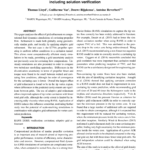
Guilherme Vaz Thomas Lloyd, Douwe Rijpkema
Fifth International Symposium on Marine Propulsors smp’17, 2017.
Abstract | Links | BibTeX | Tags: adaptive grid refinement, cavitation, DDES, RANS, verification
@conference{Lloyd2017,
title = {Computational fluid dynamics prediction of marine propeller cavitation including solution verification},
author = {Thomas Lloyd, Guilherme Vaz, Douwe Rijpkema, Antoine Reverberi},
url = {http://www.marin.nl/web/Publications/Publication-items/Computational-fluid-dynamics-prediction-of-marine-propeller-cavitation-including-solution-verification.htm},
year = {2017},
date = {2017-06-01},
booktitle = {Fifth International Symposium on Marine Propulsors smp’17},
abstract = {This paper analyses the effect of grid refinement on computational fluid dynamics simulations of cavitating propeller flow. Refinement is made both globally, using geometrically similar grids, and locally, by applying adaptive grid refinement. The test case is the E779A propeller operating in uniform inflow conditions in a cavitation tunnel. This allows more computationally efficient steady simulations to be made, permitting a grid uncertainty analysis not previously seen for cavitating flow computations. Unsteady simulations are also presented in order to compare two turbulence modelling approaches. Differences in the discretisation uncertainty in terms of propeller thrust and torque were found to be small between wetted and cavitating flow conditions, although the order of convergence for the cavitating case is lower. Overall the largest effect of grid refinement is found to be in the tip vortex region, where differences in the predicted cavity extents are significant between grids. The use of adaptive grid refinement allows improved capture of tip vortex cavitation with fewer total grid cells, although the cavity extent is limited by increasing eddy viscosity when using RANS. Application of DDES reduces this influence somewhat, motivating further study into the potential of scale-resolving simulations in combination with adaptive grid refinement for vortex cavitation prediction.},
keywords = {adaptive grid refinement, cavitation, DDES, RANS, verification},
pubstate = {published},
tppubtype = {conference}
}
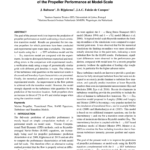
J. Baltazar, Rijpkema; Falcão de Campos, J. A. C.
Fifth International Symposium on Marine Propulsors (SMP), Espoo, Finland, 2017.
Abstract | Links | BibTeX | Tags: Marine Propeller, RANS Equations, Transitional Flow, Turbulence and Transition Models.
@conference{Baltazar2017,
title = {On the Use of the γ−Re˜ θ Transition Model for the Prediction of the Propeller Performance at Model-Scale},
author = {Baltazar, J., Rijpkema, D. and Falcão de Campos, J.A.C.},
url = {http://www.marin.nl/web/Publications/Publication-items/On-the-Use-of-the-gReth-Transition-Model-for-the-Prediction-of-the-Propeller-Performance-at-ModelScale.htm},
year = {2017},
date = {2017-06-01},
booktitle = {Fifth International Symposium on Marine Propulsors (SMP), Espoo, Finland},
abstract = {The goal of the present work is to improve the prediction of propeller performance at model-scale using a local correlation transition model. Results are presented for two marine propellers for which paint-tests have been conducted and experimental open-water data is available. The numerical results using the k − ω SST turbulence model and the γ − Re˜ θ transition model are compared with the experiments. In order to distinguish between numerical and modelling errors in the comparison with experimental results, a verification study using a range of geometrically similar grids with different grid densities is made. The influence of the turbulence inlet quantities on the numerical results is discussed and boundary-layer characteristics are presented. Finally, the numerical predictions are compared with the experimental results. An improvement in the flow pattern is achieved with the transition model. However, the model strongly depends on the turbulence inlet quantities for the prediction of the transition location. Both propellers show an increase in thrust of 2% to 4% and similar torque when using the transition model.},
keywords = {Marine Propeller, RANS Equations, Transitional Flow, Turbulence and Transition Models.},
pubstate = {published},
tppubtype = {conference}
}
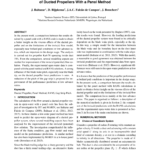
J. Baltazar, Rijpkema; Bosschers, J.
Prediction of the Open-Water Performance of Ducted Propellers With a Panel Method Conference
Fifth International Symposium on Marine Propulsors (SMP), Espoo, Finland, 2017.
Abstract | Links | BibTeX | Tags: Ducted Propeller, Gap Strip Pitch., Panel Method, RANS
@conference{Baltazar2017b,
title = {Prediction of the Open-Water Performance of Ducted Propellers With a Panel Method},
author = {Baltazar, J., Rijpkema, D.R., Falcão de Campos, J.A.C. and Bosschers, J.},
url = {http://www.marin.nl/web/Publications/Publication-items/Prediction-of-the-OpenWater-Performance-of-Ducted-Propellers-With-a-Panel-Method.htm},
year = {2017},
date = {2017-06-01},
booktitle = {Fifth International Symposium on Marine Propulsors (SMP), Espoo, Finland},
abstract = {In the present work, a comparison between the results obtained by a panel code with a RANS code is made to obtain a better insight on the viscous effects of the ducted propeller and on the limitations of the inviscid flow model, especially near bollard pull conditions or low advance ratios, which are important in the design stage. The analysis is carried out for propeller Ka4-70 operating inside duct 19A. From the comparison, several modelling aspects are studied for improvement of the inviscid (potential) flow solution. Finally, the experimental open-water data is compared with the panel method and RANS solutions. A strong influence of the blade wake pitch, especially near the blade tip, on the ducted propeller force predictions is seen. A reduction of the pitch of the gap strip is proposed for improvement of the performance prediction at low advance ratios.},
keywords = {Ducted Propeller, Gap Strip Pitch., Panel Method, RANS},
pubstate = {published},
tppubtype = {conference}
}
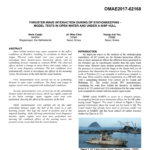
Jin Woo Choi Hans Cozijn (MARIN), Young-Jun You (DSME)
Thruster-wave Interaction during DP Stationkeeping - Model Tests in Open Water and under a Ship Hull Conference
OMAE ASME 36th International Conference on Ocean, Offshore and Arctic Engineering, Trondheim, Norway, 2017.
Abstract | Links | BibTeX | Tags: Segero, thruster-wave interaction effects, thrusters, vessel motions
@conference{(MARIN)2017,
title = {Thruster-wave Interaction during DP Stationkeeping - Model Tests in Open Water and under a Ship Hull},
author = {Hans Cozijn (MARIN), Jin Woo Choi, Young-Jun You (DSME)},
url = {http://www.marin.nl/web/Publications/Publication-items/Thrusterwave-Interaction-during-DP-Stationkeeping-Model-Tests-in-Open-Water-and-under-a-Ship-Hull.htm},
year = {2017},
date = {2017-06-01},
booktitle = {OMAE ASME 36th International Conference on Ocean, Offshore and Arctic Engineering, Trondheim, Norway},
abstract = {Wave orbital motions may cause variations in the inflow conditions of thrusters, resulting in variations in thrust and torque. Physical scale model tests were carried out to investigate these thruster-wave interaction effects, with an azimuthing thruster running at constant RPMs. The observed effects include a change in mean thrust and torque values, as well as wave frequency variations. The test conditions were systematically varied to investigate the effects of the incoming waves, the presence of the hull and the vessel motions.
First, measurements were carried out on an azimuthing thruster in open water conditions. The thrust and torque in regular waves were compared with bollard pull conditions.
Second, measurements were carried out on the azimuthing thruster under the hull of a vessel, which was rigidly connected to the basin carriage. Again, regular wave tests were performed, showing the effect of the presence of the hull.
Third, measurements were carried out on the same azimuthing thruster under the hull of the vessel in a softmooring system. This kept the vessel in position and at the required heading, while allowing unrestricted wave frequency motions. Again, regular wave tests were performed, now showing the combined effects of the passing waves, the presence of the vessel hull and the vessel motions.},
keywords = {Segero, thruster-wave interaction effects, thrusters, vessel motions},
pubstate = {published},
tppubtype = {conference}
}
First, measurements were carried out on an azimuthing thruster in open water conditions. The thrust and torque in regular waves were compared with bollard pull conditions.
Second, measurements were carried out on the azimuthing thruster under the hull of a vessel, which was rigidly connected to the basin carriage. Again, regular wave tests were performed, showing the effect of the presence of the hull.
Third, measurements were carried out on the same azimuthing thruster under the hull of the vessel in a softmooring system. This kept the vessel in position and at the required heading, while allowing unrestricted wave frequency motions. Again, regular wave tests were performed, now showing the combined effects of the passing waves, the presence of the vessel hull and the vessel motions.
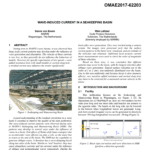
van Essen en Wim Lafeber, Sanne
Wave-induced current in a seakeeping basin Conference
Proceedings of the ASME 2017 36th International Conference on Ocean, Offshore and Arctic Engineering, OMAE2017, Trondheim, Norway, 2017.
Abstract | BibTeX | Tags: Seakeeping and Manoeuvring Basin, wave-induced current
@conference{vanenLafeber2017,
title = {Wave-induced current in a seakeeping basin},
author = {Sanne van Essen en Wim Lafeber},
year = {2017},
date = {2017-06-01},
booktitle = {Proceedings of the ASME 2017 36th International Conference on Ocean, Offshore and Arctic Engineering, OMAE2017, Trondheim, Norway},
pages = {OMAE2017-62203},
abstract = {During tests in MARIN’s wave basins, it was observed that large-scale current patterns may develop under the influence of wave generation and absorption. The velocity of these currents is very low, so they generally do not influence the behaviour of models. However, for specific experiments at low speeds – wave added resistance tests with small models or current drag tests – a residual current may influence the results significantly. Figure 1: Seakeeping and Manoeuvring Basin.
A good understanding of the residual circulation in a wave basin is essential to improve the quality of the tests performed. The wave-induced current patterns were observed during tests in MARIN’s Seakeeping and Manoeuvring Basin (SMB). The patterns may develop in several ways under the influence of waves in a basin. End effects of Stokes drift (mass transport due to second-order wave effects) can play a role, as the water has to return at the end of the basin. The SMB has the capability to generate oblique waves. It therefore has a wave-damping beach along two sides of the basin. Similar to ‘real’ beaches, they may cause alongshore currents and rip currents under the influence of oblique and perpendicular waves respectively. During the tests, floaters in the form of oranges were distributed in the basin after wave generation.
They were tracked using a camera system. The images were processed such that the surface current patterns in the basin were visualized, and an estimate of the velocities was obtained. Additional local acoustic current meter measurements were used to check the order of magnitude of these velocities. Based on these tests, it was concluded that different patterns may occur in the basin, with the largest velocities after oblique wave generation. Typical surface velocities are in the order of 1 to 2 cm/s, non-uniformly distributed over the basin. Due to this non-uniformity and because decay is slow (memory effects), very sensitive added resistance and current drag tests may have to be corrected for a measured current velocity in the future.},
keywords = {Seakeeping and Manoeuvring Basin, wave-induced current},
pubstate = {published},
tppubtype = {conference}
}
A good understanding of the residual circulation in a wave basin is essential to improve the quality of the tests performed. The wave-induced current patterns were observed during tests in MARIN’s Seakeeping and Manoeuvring Basin (SMB). The patterns may develop in several ways under the influence of waves in a basin. End effects of Stokes drift (mass transport due to second-order wave effects) can play a role, as the water has to return at the end of the basin. The SMB has the capability to generate oblique waves. It therefore has a wave-damping beach along two sides of the basin. Similar to ‘real’ beaches, they may cause alongshore currents and rip currents under the influence of oblique and perpendicular waves respectively. During the tests, floaters in the form of oranges were distributed in the basin after wave generation.
They were tracked using a camera system. The images were processed such that the surface current patterns in the basin were visualized, and an estimate of the velocities was obtained. Additional local acoustic current meter measurements were used to check the order of magnitude of these velocities. Based on these tests, it was concluded that different patterns may occur in the basin, with the largest velocities after oblique wave generation. Typical surface velocities are in the order of 1 to 2 cm/s, non-uniformly distributed over the basin. Due to this non-uniformity and because decay is slow (memory effects), very sensitive added resistance and current drag tests may have to be corrected for a measured current velocity in the future.
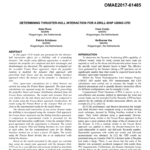
A.H. Koop, Cozijn; Vaz, G.
Determining Thruster-Hull Interaction for a Drill-Ship Using CFD Conference
OMAE ASME 36th International Conference on Ocean, Offshore and Arctic Engineering, Trondheim, Norway, 2017.
Abstract | Links | BibTeX | Tags: CFD, thruster-hull interaction
@conference{Koop2017,
title = {Determining Thruster-Hull Interaction for a Drill-Ship Using CFD},
author = {Koop, A.H., Cozijn, H.C., Schrijvers, P. and Vaz, G.},
url = {http://www.marin.nl/web/Publications/Publication-items/Determining-ThrusterHull-Interaction-for-a-DrillShip-Using-CFD.htm},
year = {2017},
date = {2017-06-01},
booktitle = {OMAE ASME 36th International Conference on Ocean, Offshore and Arctic Engineering, Trondheim, Norway},
pages = {OMAE2017-61485},
abstract = {In this paper CFD results are presented for the thruster-hull interaction effects for a drillship with 6 azimuthing thrusters. The results using different approaches to model or simulate the propeller are compared and their advantages and disadvantages are discussed. The approaches investigated are the so-called Frozen Rotor approach, where the propeller rotation is modeled, the Actuator Disk approach with prescribed body forces and the unsteady Sliding Interface approach where the motion of the propeller is simulated in time.
First, open-water calculations for a tilted thruster are carried out using the Frozen Rotor approach. The open-water calculations are repeated using the Actuator Disk prescribing the propeller thrust and torque distribution obtained from the Frozen Rotor calculations. The results with Actuator Disk are very similar for the unit thrust and nozzle thrust compared to the results using the Frozen Rotor approach. Furthermore, the results using the Frozen Rotor or the Actuator Disk are very close to the experimental results for the nozzle thrust.
The thruster-hull interaction of one active thruster under the drillship is investigated using the Actuator Disk approach, the Frozen Rotor Approach and the Sliding Interface approach. A comparison to experimental results is presented for the thruster-hull interaction coefficients. Using the Actuator Disk a good agreement with the experiments is obtained. The results using the Actuator Disk and Sliding Interface are very similar to each other, but the computational costs for the Sliding Interface method are at least a factor 20 higher. The results using the Frozen Rotor deviate due to an unphysical wake behind the thruster.
Based on the results presented in this paper we conclude that, using the steady-state approach with the Actuator Disk, CFD can be a cost-efficient and accurate method to determine the thruster-hull interaction effects at bollard pull conditions for a typical offshore vessel.},
keywords = {CFD, thruster-hull interaction},
pubstate = {published},
tppubtype = {conference}
}
First, open-water calculations for a tilted thruster are carried out using the Frozen Rotor approach. The open-water calculations are repeated using the Actuator Disk prescribing the propeller thrust and torque distribution obtained from the Frozen Rotor calculations. The results with Actuator Disk are very similar for the unit thrust and nozzle thrust compared to the results using the Frozen Rotor approach. Furthermore, the results using the Frozen Rotor or the Actuator Disk are very close to the experimental results for the nozzle thrust.
The thruster-hull interaction of one active thruster under the drillship is investigated using the Actuator Disk approach, the Frozen Rotor Approach and the Sliding Interface approach. A comparison to experimental results is presented for the thruster-hull interaction coefficients. Using the Actuator Disk a good agreement with the experiments is obtained. The results using the Actuator Disk and Sliding Interface are very similar to each other, but the computational costs for the Sliding Interface method are at least a factor 20 higher. The results using the Frozen Rotor deviate due to an unphysical wake behind the thruster.
Based on the results presented in this paper we conclude that, using the steady-state approach with the Actuator Disk, CFD can be a cost-efficient and accurate method to determine the thruster-hull interaction effects at bollard pull conditions for a typical offshore vessel.
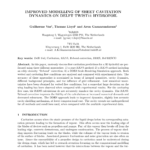
Guilherme Vaz, Thomas Lloyd; Gnanasundaram, Arun
Improved Modelling Of Sheet Cavitation Dynamics On Delft Twistll Hydrofoil Conference
VII International Conference on Computational Methods in Marine Engineering, 2017.
Abstract | Links | BibTeX | Tags: cavitation, DDES, Delft Foil, RANS, Reboud-correction, ReFRESCO
@conference{Vaz2017,
title = {Improved Modelling Of Sheet Cavitation Dynamics On Delft Twistll Hydrofoil},
author = {Guilherme Vaz, Thomas Lloyd and Arun Gnanasundaram},
url = {http://www.marin.nl/web/Publications/Publication-items/Improved-Modelling-Of-Sheet-Cavitation-Dynamics-On-Delft-Twistll-Hydrofoil.htm},
year = {2017},
date = {2017-05-01},
booktitle = {VII International Conference on Computational Methods in Marine Engineering},
abstract = {In this paper, unsteady viscous-flow cavitation predictions for a 3D hydrofoil are performed using three different approaches: 1) a pure RANS method; 2) a RANS method including an eddy-viscosity “Reboud” correction; 3) a DDES Scale-Resolving-Simulation approach. Both wetted and cavitating flow conditions are analysed and compared with experimental data. The accuracy of these approaches is scrutinised in terms of integral quantities, cavity dynamics, different background principles, and the influence of grid refinement. Low numerical uncertainties have been obtained for wetted flow conditions, but a somewhat large deviation on the wing loading has been observed when compared with experimental results. For the cavitating flow case, the RANS calculations do not accurately simulate the cavity dynamics. The RANSReboud correction improves the fidelity of the calculations at increased numerical demands and decreased robustness. The DDES approach leads to improved dynamics, slightly less accurate cavity shedding mechanism, at lower computational cost. The cavity extents are underpredicted for all methods and conditions used, when compared with the available experimental data.},
keywords = {cavitation, DDES, Delft Foil, RANS, Reboud-correction, ReFRESCO},
pubstate = {published},
tppubtype = {conference}
}
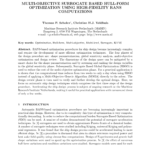
Thomas P. Scholcz, Christian H. J. Veldhuis
Multi-Objective Surrogate Based Hull-Form Optimization Using High-Fidelity RANS Computations Conference
VII International Conference on Computational Methods in Marine Engineering (MARINE 2017), 2017.
Abstract | Links | BibTeX | Tags: Hull-form, Multi-level, Multi-objective, optimization, RANS, Surrogate
@conference{Scholcz2017,
title = {Multi-Objective Surrogate Based Hull-Form Optimization Using High-Fidelity RANS Computations},
author = {Thomas P. Scholcz, Christian H.J. Veldhuis},
url = {http://www.marin.nl/web/Publications/Publication-items/MultiObjective-Surrogate-Based-HullForm-Optimization-Using-HighFidelity-RANS-Computations.htm},
year = {2017},
date = {2017-05-01},
booktitle = {VII International Conference on Computational Methods in Marine Engineering (MARINE 2017)},
abstract = {RANS-based optimization procedures for ship design become increasingly complex and require the development of more efficient optimization techniques. The four phases of the design procedure are: shape parameterization, global sensitivity analysis, multi-objective optimization and design review. The dimensions of the design space can be mitigated by a smart choice for the shape parameterization and by screening and ranking the design variables in the global sensitivity phase. Subsequently, Surrogate Based Global Optimization (SBGO) is used to reduce the cost of the multi-objective optimization phase. For a practical application it is shown that the computational time reduces from two weeks to only a day when using SBGO instead of applying a Multi-Objective Genetic Algorithm (MOGA) directly to the solver. The design review phase is then used to verify and further develop the optimal design. Here, we focus on automatic ship design techniques which comprises the first three steps of the design procedure. Accelerating the ship design process is subject of ongoing research at the Maritime Research Institute Netherlands, making it useful for practical applications with turnaround times of only a few weeks.},
keywords = {Hull-form, Multi-level, Multi-objective, optimization, RANS, Surrogate},
pubstate = {published},
tppubtype = {conference}
}

THOMAS LLOYD CARLO NEGRATO, TOM VAN TERWISGA; BENSOW, RICKARD
NUMERICAL STUDY OF CAVITATION ON A NACA0015 HYDROFOIL: SOLUTION VERIFICATION Conference
VII International Conference on Computational Methods in Marine Engineering, 2017.
Abstract | Links | BibTeX | Tags: cavitation, Discretization Error, NACA0015 foil, RANS, verification
@conference{NEGRATO2017,
title = {NUMERICAL STUDY OF CAVITATION ON A NACA0015 HYDROFOIL: SOLUTION VERIFICATION},
author = {CARLO NEGRATO, THOMAS LLOYD, TOM VAN TERWISGA, GUILHERME VAZ AND RICKARD BENSOW},
url = {http://www.marin.nl/web/Publications/Publication-items/Numerical-Study-Of-Cavitation-On-A-NACA0015-Hydrofoil-Solution-Verification.htm},
year = {2017},
date = {2017-05-01},
booktitle = {VII International Conference on Computational Methods in Marine Engineering},
abstract = {The present paper analyses a series of Computational Fluid Dynamic simulations of the cavitating flow around a two-dimensional NACA0015 foil. The foil is placed at 6◦ angle of attack and the cavitation number is 1.1. Two mesh designs, namely a block-structured topology and an unstructured topology, are compared; additionally, grid refinements and time step refinements are carried out. Solution Verification is addressed with calculation of the discretization error and the numerical uncertainty. The numerical uncertainty for the average lift coefficient is found to be large, up to 15%. The reason is the difficulty of achieving a grid independent solution: with very fine meshes, the flow shifts from an attached, oscillating sheet cavity pattern to a regime dominated by shedding of cavity clouds. On the other hand, neither the time resolution nor the choice of grid topology influence largely the flow pattern; instead, they only lead to differences in the maximum and minimum cavity size.},
keywords = {cavitation, Discretization Error, NACA0015 foil, RANS, verification},
pubstate = {published},
tppubtype = {conference}
}
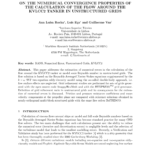
Ana Lu´ısa Rocha, Lu´ıs E¸ca; Vaz, Guilherme
VII International Conference on Computational Methods in Marine Engineering, 2017.
Abstract | Links | BibTeX | Tags: KVLCC2, Numerical Error, RANS, Unstructured Grids
@conference{Rocha2017,
title = {ON THE NUMERICAL CONVERGENCE PROPERTIES OF THE CALCULATION OF THE FLOW AROUND THE KVLCC2 TANKER IN UNSTRUCTURED GRIDS},
author = {Ana Lu´ısa Rocha, Lu´ıs E¸ca and Guilherme Vaz},
url = {http://www.marin.nl/web/Publications/Publication-items/On-The-Numerical-Convergence-Properties-Of-The-Calculation-Of-The-Flow-Around-The-KVLCC2-Tanker-In-Unstructured-Grids.htm},
year = {2017},
date = {2017-05-01},
booktitle = {VII International Conference on Computational Methods in Marine Engineering},
abstract = {This paper addresses the estimation of numerical errors in the calculation of the flow around the KVLCC2 tanker at model scale Reynolds number in unstructured grids. The flow solution is based on the Reynolds-Averaged Navier-Stokes equations supplemented by the k − ω SST two-equation eddy-viscosity model using the so-called double-body approach, i.e. free surface effects are neglected. Grid refinement studies are performed for sets of grids generated with the open source code SnappyHexMesh and with the HEXPRESSTM grid generator. Definition of grid refinement ratio in unstructured grids and its consequences for the estimation of numerical errors is discussed. Friction and pressure resistance coefficients and mean velocity components at the propeller plane are compared with reference solutions obtained in nearly-orthogonal multi-block structured grids with the same flow solver ReFRESCO.},
keywords = {KVLCC2, Numerical Error, RANS, Unstructured Grids},
pubstate = {published},
tppubtype = {conference}
}
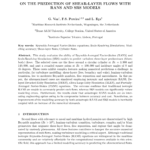
G. Vaz, F. S. Pereira; E¸ca, L.
ON THE PREDICTION OF SHEAR-LAYER FLOWS WITH RANS AND SRS MODELS Conference
VII International Conference on Computational Methods in Marine Engineering, 2017.
Abstract | Links | BibTeX | Tags: Reynolds-Averaged Navier-Stokes equations; Scale-Resolving Simulations; Mod-elling accuracy; Shear-layer flows; Cylinder flows
@conference{Vaz2017b,
title = {ON THE PREDICTION OF SHEAR-LAYER FLOWS WITH RANS AND SRS MODELS},
author = {G. Vaz, F.S. Pereira and L. E¸ca},
url = {http://www.marin.nl/web/Publications/Publication-items/On-The-Prediction-Of-ShearLayer-Flows-With-RANS-And-SRS-Models.htm},
year = {2017},
date = {2017-05-01},
booktitle = {VII International Conference on Computational Methods in Marine Engineering},
abstract = {This study evaluates the ability of Reynolds-Averaged Navier-Stokes (RANS) and Scale-Resolving Simulations (SRS) models to predict turbulent shear-layer predominant (blunt-body) flows. The selected cases are the flows around a circular cylinder at Re = 3, 900 and 140, 000, and past a rounded square prism at Re = 100, 000 and incidence angles of 0 and 45 degrees. These cases exhibit complex features making numerical predictions a challenge, in particular, for turbulence modelling: shear-layers (free, boundary and wake), laminar-turbulent transition, low to moderate Reynolds numbers, flow separation and unsteadiness. In this pa-per, the aforementioned cases are simulated employing isotropic and anisotropic RANS, De-layed Detached-Eddy Simulation (DDES), eXtra Large-Eddy Simulation (XLES), and Partially-Averaged Navier-Stokes (PANS) equations. The outcome confirms that traditional isotropic RANS are unable to accurately predict such flows, whereas SRS models can significantly reduce modelling errors. Furthermore, the results show that anisotropic RANS models are an inter-esting engineering option owing to its compromise between accuracy and cost. Nonetheless, an improvement of the modelling accuracy by both anisotropic RANS and SRS models is inevitably coupled with an increase of the numerical demands.},
keywords = {Reynolds-Averaged Navier-Stokes equations; Scale-Resolving Simulations; Mod-elling accuracy; Shear-layer flows; Cylinder flows},
pubstate = {published},
tppubtype = {conference}
}
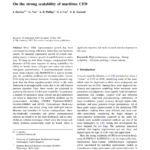
G. Vaz J. Hawkes, A. B. Phillips
On the strong scalability of maritime CFD Journal Article
In: Journal of Marine Science and Technology, no. DOI: 10.1007/s00773-017-0457-7, 2017.
Abstract | Links | BibTeX | Tags: High-performance computing, Linear solvers, Software profiling, Strong scalability
@article{Hawkes2017,
title = {On the strong scalability of maritime CFD},
author = {J. Hawkes, G. Vaz, A. B. Phillips, S. J. Cox, S. R. Turnock},
url = {http://www.marin.nl/web/Publications/Publication-items/On-the-strong-scalability-of-maritime-CFD.htm},
year = {2017},
date = {2017-05-01},
booktitle = {Journal of Marine Science and Technology},
journal = {Journal of Marine Science and Technology},
number = {DOI: 10.1007/s00773-017-0457-7},
abstract = {Since 2004, supercomputer growth has been constrained by energy efficiency rather than raw hardware speeds. To maintain exponential growth of overall computing power, a massive growth in parallelization is under way. To keep up with these changes, computational fluid dynamics (CFD) must improve its strong scalability—its ability to handle lower cells-per-core ratios and achieve finer-grain parallelization. A maritime-focused, unstructured, finite-volume code (ReFRESCO) is used to investigate the scalability problems for incompressible, viscous CFD using two classical test-cases. Existing research suggests that the linear equation-system solver is the main bottleneck to incompressible codes, due to the stiff Poisson pressure equation. Here, these results are expanded by analysing the reasons for this poor scalability. In particular, a number of alternative linear solvers and preconditioners are tested to determine if the scalability problem can be circumvented, including GMRES, Pipelined-GMRES, Flexible-GMRES and BCGS. Conventional block-wise preconditioners are tested, along with multi-grid preconditioners and smoothers in various configurations. Memory-bandwidth constraints and global communication patterns are found to be the main bottleneck, and no stateof-the-art solution techniques which solve the strong-scalability problem satisfactorily could be found. There is significant incentive for more research and development in this area.},
keywords = {High-performance computing, Linear solvers, Software profiling, Strong scalability},
pubstate = {published},
tppubtype = {article}
}
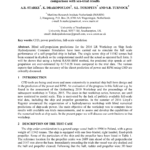
A.R. Starke, Drakopoulos; Turnock, S. R.
VII International Conference on Computational Methods in Marine Engineering (MARINE2017), 2017.
Abstract | Links | BibTeX | Tags: CFD, full-scale validation, power prediction
@conference{Starke2017,
title = {RANS-based full-scale power predictions for a general cargo vessel, and comparison with sea-trial results},
author = {Starke, A.R., Drakopoulos, K., Toxopeus, S.L. and Turnock, S.R.},
url = {http://www.marin.nl/web/Publications/Publication-items/RANSbased-fullscale-power-predictions-for-a-general-cargo-vessel-and-comparison-with-seatrial-results.htm},
year = {2017},
date = {2017-05-01},
booktitle = {VII International Conference on Computational Methods in Marine Engineering (MARINE2017)},
abstract = {Blind self-propulsion predictions for the 2016 LR Workshop on Ship Scale Hydrodynamic Computer Simulation have been carried out to simulate the full scale performance of a self-propelled ship in ballast. The single screw ship of 11542 tonnes had been scanned in drydock so the computational model used the actual as operated hull form. It will be shown that using a hybrid RANS-BEM method, the predicted ship speeds at selfpropulsion are over-estimated by 0.17-0.28 knots compared to the trial data. The various aspects that influence the accuracy of the direct prediction of power and RPM using CFD are critically discussed.},
keywords = {CFD, full-scale validation, power prediction},
pubstate = {published},
tppubtype = {conference}
}
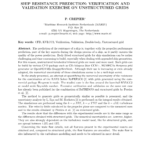
Crepier, P.
Ship Resistance Prediction: Verification And Validation Exercise On Unstructured Grids Conference
VII International Conference on Computational Methods in Marine Engineering (MARINE2017), 2017.
Abstract | Links | BibTeX | Tags: CFD, Double-body, KVLCC2, Unstructured grid, Validation, verification
@conference{Crepier2017,
title = {Ship Resistance Prediction: Verification And Validation Exercise On Unstructured Grids},
author = {Crepier, P.},
url = {http://www.marin.nl/web/Publications/Publication-items/Ship-Resistance-Prediction-Verification-And-Validation-Exercise-On-Unstructured-Grids.htm},
year = {2017},
date = {2017-05-01},
booktitle = {VII International Conference on Computational Methods in Marine Engineering (MARINE2017)},
abstract = {The prediction of the resistance of a ship is, together with the propeller performance prediction, part of the key aspects during the design process of a ship, as it partly ensures the quality of the power-prediction. Body fitted structured grids for ship simulations can be rather challenging and time consuming to build, especially when dealing with appended ship geometries. For this reason, unstructured hexahedral trimmed grids are more and more used. Such grids can be build by various CFD package such as CD-Adapcos Star CCM+, NUMECAs Hexpress grid generator or OpenFOAMSs SnappyHexMesh. Although their use is increasing or even already adopted, the numerical uncertainty of these simulations seems to be a well-kept secret.
In the study presented, an attempt at quantifying the numerical uncertainty of the resistance for the combination of the RANS Solver ReFRESCO [1] with grids generated using the commercial package Hexpress is made. The studied case is the flow around the bare-hull KVLCC2 at model scale Reynolds number. Extensive verification and validation on the same test case has already been published for the combination of ReFRESCO and structured grids by Pereira et al. [2].
The method to generate grids as geometrically similar as possible is presented, and the uncertainty analysis by L. Ec¸a and M. Hoekstra [3] is performed on the integral results obtained.
The simulations are performed using the k − ω SST, k − ω TNT and the k −√kL turbulence models. The velocity fields calculated in the propeller plane are compared to the measured ones and to the results obtained by Pereira et al. [2] on structured grids.
The results show that the differences with the experimental results are in the same range as the differences obtained with structured grids. The numerical uncertainties are, however, higher. They are also strongly dependent on the turbulence model used, like for structured grids, and are spread between 1.3% and 12%.
Concerning the wake flow details, not all features present in the experimental results are obtained and, compared to structured grids, the flow features are smoothed. The wake flow is also influenced by the turbulence modelling and needs to be adressed in more detail.},
keywords = {CFD, Double-body, KVLCC2, Unstructured grid, Validation, verification},
pubstate = {published},
tppubtype = {conference}
}
In the study presented, an attempt at quantifying the numerical uncertainty of the resistance for the combination of the RANS Solver ReFRESCO [1] with grids generated using the commercial package Hexpress is made. The studied case is the flow around the bare-hull KVLCC2 at model scale Reynolds number. Extensive verification and validation on the same test case has already been published for the combination of ReFRESCO and structured grids by Pereira et al. [2].
The method to generate grids as geometrically similar as possible is presented, and the uncertainty analysis by L. Ec¸a and M. Hoekstra [3] is performed on the integral results obtained.
The simulations are performed using the k − ω SST, k − ω TNT and the k −√kL turbulence models. The velocity fields calculated in the propeller plane are compared to the measured ones and to the results obtained by Pereira et al. [2] on structured grids.
The results show that the differences with the experimental results are in the same range as the differences obtained with structured grids. The numerical uncertainties are, however, higher. They are also strongly dependent on the turbulence model used, like for structured grids, and are spread between 1.3% and 12%.
Concerning the wake flow details, not all features present in the experimental results are obtained and, compared to structured grids, the flow features are smoothed. The wake flow is also influenced by the turbulence modelling and needs to be adressed in more detail.
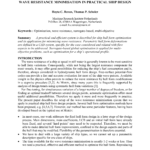
Raven, H. C.; Scholcz, T. P.
Wave Resistance Minimisation In Practical Ship Design Conference
VII International Conference on Computational Methods in Marine Engineering (MARINE2017), Nantes, France, 2017.
Abstract | Links | BibTeX | Tags: Multi-objective, Optimisation, surrogate-based, wave resistance
@conference{Raven2017,
title = {Wave Resistance Minimisation In Practical Ship Design},
author = {Raven, H.C. and Scholcz, T.P.},
url = {http://www.marin.nl/web/Publications/Publication-items/Wave-Resistance-Minimisation-In-Practical-Ship-Design.htm},
year = {2017},
date = {2017-05-01},
booktitle = {VII International Conference on Computational Methods in Marine Engineering (MARINE2017), Nantes, France},
pages = {131-142},
abstract = {A practical and efficient system is described for ship hull form optimisation and its application for minimising wave resistance. Parametric hull form deformations are defined in a CAD system, specific for the case considered and related with flow aspects to be addressed. Surrogate-based global optimisation is applied for multiobjective problems, such as optimisation for a ship’s operational profile. },
keywords = {Multi-objective, Optimisation, surrogate-based, wave resistance},
pubstate = {published},
tppubtype = {conference}
}
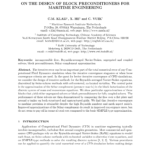
C.M. Klaij, He; Vuik, C.
On The Design Of Block Preconditioners For Maritime Engineering Conference
VII International Conference on Computational Methods in Marine Engineering (MARINE2017), Nantes, France, 2017.
Abstract | Links | BibTeX | Tags: block preconditioners, incompressible flow, Reynolds-averaged Navier-Stokes, Schur complement approximation, segregated and coupled solvers
@conference{Klaij2017,
title = {On The Design Of Block Preconditioners For Maritime Engineering},
author = {Klaij, C.M., He, X. and Vuik, C.},
url = {http://www.marin.nl/web/Publications/Publication-items/On-The-Design-Of-Block-Preconditioners-For-Maritime-Engineering.htm},
year = {2017},
date = {2017-05-01},
booktitle = {VII International Conference on Computational Methods in Marine Engineering (MARINE2017), Nantes, France},
pages = {893-904},
abstract = {The iterative error can be an important part of the total numerical error of any Computational Fluid Dynamics simulation when the iterative convergence stagnates or when loose convergence criteria are used. In the quest for better iterative convergence of CFD simulations, we consider the design of iterative methods for the Reynolds-averaged Navier-Stokes equations, discretized by finite-volume methods with cell-centered, co-located variables. The central point is the approximation of the Schur complement (pressure matrix) in the block factorization of the discrete system of mass and momentum equations. We show particular approximations of these blocks that yield either segregated solvers or block preconditioners for fully coupled solvers. The performance of these solvers are then demonstrated by computing the flow over a flat plate and around a tanker on both structured and unstructured grids. We find that iterative convergence to machine precision is attainable despite the high Reynolds numbers and mesh aspect ratio's. Improved approximations of the Schur complement do result in improved convergence rates, but do not seem to pay-off in terms of total cost compared to the basic SIMPLE-type approximation.},
keywords = {block preconditioners, incompressible flow, Reynolds-averaged Navier-Stokes, Schur complement approximation, segregated and coupled solvers},
pubstate = {published},
tppubtype = {conference}
}
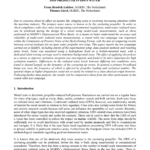
Lafeber, Frans Hendrik; Lloyd, Thomas
Round Robin test on the underwater radiated noise of a cavitating ship propeller in open water Conference
The 5th international conference on advanced model measurements technology (AMT '17) 11/13-10-2017, 2017.
Abstract | Links | BibTeX | Tags: Depressurized Wave Basin, shipping noise, underwater radiated noise
@conference{Lafeber2017,
title = {Round Robin test on the underwater radiated noise of a cavitating ship propeller in open water},
author = {Frans Hendrik Lafeber and Thomas Lloyd},
url = {http://www.marin.nl/web/Publications/Publication-items/Round-Robin-test-on-the-underwater-radiated-noise-of-a-cavitating-ship-propeller-in-open-water.htm},
year = {2017},
date = {2017-01-11},
booktitle = {The 5th international conference on advanced model measurements technology (AMT '17) 11/13-10-2017},
abstract = {Due to concerns about its effect on marine life, shipping noise is receiving increasing attention within the maritime industry. The primary noise source is known to be the cavitating propeller. In order to check compliance with class rules and upcoming environmental regulations, underwater radiated noise can be predicted during the design of a vessel using model-scale measurements, such as those performed at MARIN’s Depressurized Wave Basin. As a means to better understand the accuracy and reliability of underwater radiated noise measurements, a round robin test campaign was organised within the Community-of-Practice Noise of the HydroTesting Forum, with the aim of comparing results between several institutes for an open water propeller test setup. This paper reports the test campaign carried out at MARIN, including details of the experimental setup, data analysis methods and resulting noise levels. Noise was measured using a hydrophone fixed on a bottom-mounted mast, with a dedicated silent towing carriage used to minimise background noise. The effect of applying electrolysis as a means to improve cavitation inception was investigated, and found to be more important for high cavitation numbers. Differences in the radiated noise levels between different test conditions were found to depend largely on the dynamics of the cavitating tip vortex. In general a primary broadband hump was seen, the frequency of which is affected by propeller loading and cavitation number. The spectral shape at higher frequencies could not so easily be related to a clear physical origin however. Following further data analysis, the results will be compared to those from the other participants in the round robin test campaign.},
keywords = {Depressurized Wave Basin, shipping noise, underwater radiated noise},
pubstate = {published},
tppubtype = {conference}
}
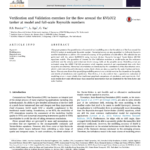
F.S. Pereira, Eça; Vaz, G.
Verification and Validation exercises for the flow around the KVLCC2 tanker at model and full-scale Reynolds numbers Journal Article
In: Ocean Engineering, vol. 129, no. DOI: 10.1016/j.oceaneng.2016.11.005, pp. 133-148, 2017.
Abstract | Links | BibTeX | Tags: KVLCC2, Modelling error, Numerical Error, RANS, Turbulence modelling
@article{Pereira2017,
title = {Verification and Validation exercises for the flow around the KVLCC2 tanker at model and full-scale Reynolds numbers},
author = {Pereira, F.S., Eça, L. and Vaz, G.},
url = {http://www.marin.nl/web/Publications/Publication-items/Verification-and-Validation-exercises-for-the-flow-around-the-KVLCC2-tanker-at-model-and-fullscale-Reynolds-numbers.htm},
year = {2017},
date = {2017-01-02},
booktitle = {Ocean Engineering},
journal = {Ocean Engineering},
volume = {129},
number = {DOI: 10.1016/j.oceaneng.2016.11.005},
pages = {133-148},
abstract = {This paper presents the quantification of numerical and modelling errors for the solution of the flow around the KVLCC2 tanker at model-scale Reynolds number. Numerical errors are also quantified for full-scale Reynolds number simulations to address the numerical accuracy of the prediction of scale-effects. The calculations are performed with the solver ReFRESCO using fourteen distinct Reynolds-Averaged Navier-Stokes (RANS) equations models. The quantities of interest for the Validation exercises at model-scale are the resistance coefficient and the velocity and turbulence kinetic energy fields at the propeller plane. Modelling errors are estimated using the ASME V & V20 procedure which requires numerical and experimental data with their respective uncertainties. Numerical uncertainties are dominated by the contribution of the discretization error, which is determined by grid refinement studies. Scale-effects are also assessed for the wake-fraction and formfactor. The outcome shows that quantifying modelling errors is not a trivial exercise that depends on the quality and details of simulations and experiments. Nonetheless, it is also evident that a quantitative evaluation of modelling errors is more reliable than traditional graphical comparisons of simulations and experiments. Fullscale results show scale-effects larger than numerical uncertainties that are illustrated for the form-factor and wake-fraction.},
keywords = {KVLCC2, Modelling error, Numerical Error, RANS, Turbulence modelling},
pubstate = {published},
tppubtype = {article}
}
2016
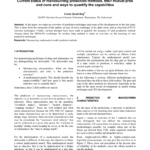
Quadvlieg, F. H. H. A.
Yücel Odabaşı Colloquium Series - 2nd International Meeting Recent Advances in Prediction Techniques for Safe Manoeuvring of Ships and Submarines, Istanbul, Turkey, 2016.
Abstract | Links | BibTeX | Tags: Manoeuvring, mathematical model, prediction methods
@conference{Quadvlieg2016,
title = {Current status of manoeuvring prediction methods, their mutual pros and cons and ways to quantify the capabilities},
author = {Quadvlieg, F.H.H.A.},
url = {http://www.marin.nl/web/Publications/Papers/Current-status-of-manoeuvring-prediction-methods-their-mutual-pros-and-cons-and-ways-to-quantify-the-capabilities.htm},
year = {2016},
date = {2016-11-17},
booktitle = {Yücel Odabaşı Colloquium Series - 2nd International Meeting Recent Advances in Prediction Techniques for Safe Manoeuvring of Ships and Submarines, Istanbul, Turkey},
abstract = {In the paper, we make an overview of prediction techniques and some of the developments in the last years. This is done from the viewpoint of the author: as user of every technique in his daily work, and as observed of ITTC common techniques. Finally, various attempts have been made to quantify the accuracy of each prediction method. Among others the SIMMAN workshops for surface ships enabled to make an overview on the maturing of new prediction techniques.},
keywords = {Manoeuvring, mathematical model, prediction methods},
pubstate = {published},
tppubtype = {conference}
}
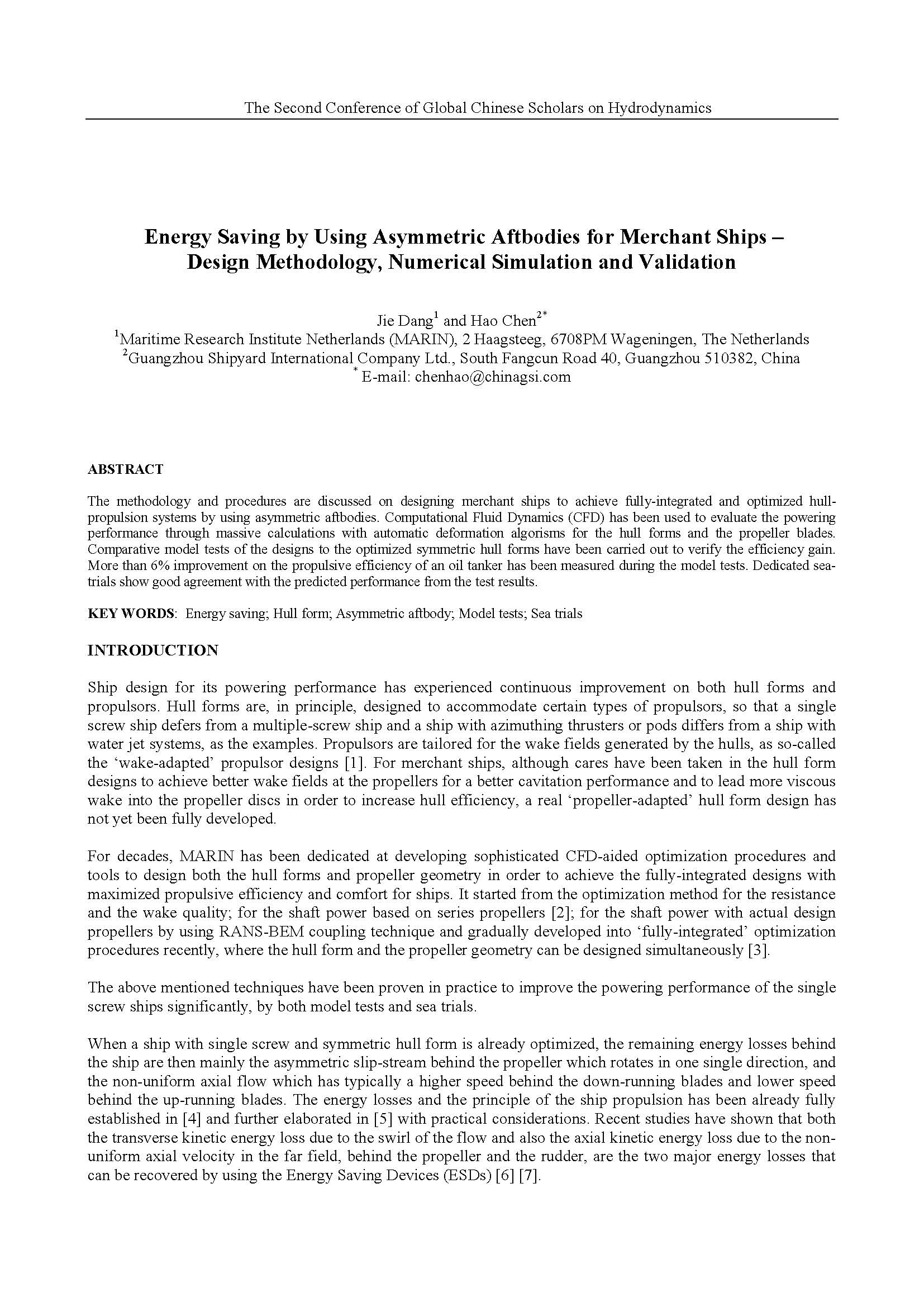
Jie; Chen Dang, Hao
The Second Conference of Global Chinese Scholars on Hydrodynamics, CCSH'2016, 2016.
Abstract | Links | BibTeX | Tags: EEDI, efficiency, Energy Saving Device, ESD, Fuel consumption, full scale, measurement, sea trial, ship design
@conference{Dang2016,
title = {Energy Saving by Using Asymmetric Aftbodies for Merchant Ships – Design Methodology, Numerical Simulation and Validation},
author = {Dang, Jie; Chen, Hao},
url = {http://www.marin.nl/web/Publications/Papers/Energy-Saving-by-Using-Asymmetric-Aftbodies-for-Merchant-Ships-Design-Methodology-Numerical-Simulation-and-Validation.htm },
year = {2016},
date = {2016-11-11},
booktitle = {The Second Conference of Global Chinese Scholars on Hydrodynamics},
publisher = {CCSH'2016},
abstract = {The methodology and procedures are discussed on designing merchant ships to achieve fully-integrated and optimized hull-propulsion systems by using asymmetric aftbodies. Computational Fluid Dynamics (CFD) has been used to evaluate the powering performance through massive calculations with automatic deformation algorisms for the hull forms and the propeller blades. Comparative model tests of the designs to the optimized symmetric hull forms have been carried out to verify the efficiency gain. More than 6% improvement on the propulsive efficiency of an oil tanker has been measured during the model tests. Dedicated sea-trials show good agreement with the predicted performance from the test results.},
keywords = {EEDI, efficiency, Energy Saving Device, ESD, Fuel consumption, full scale, measurement, sea trial, ship design},
pubstate = {published},
tppubtype = {conference}
}
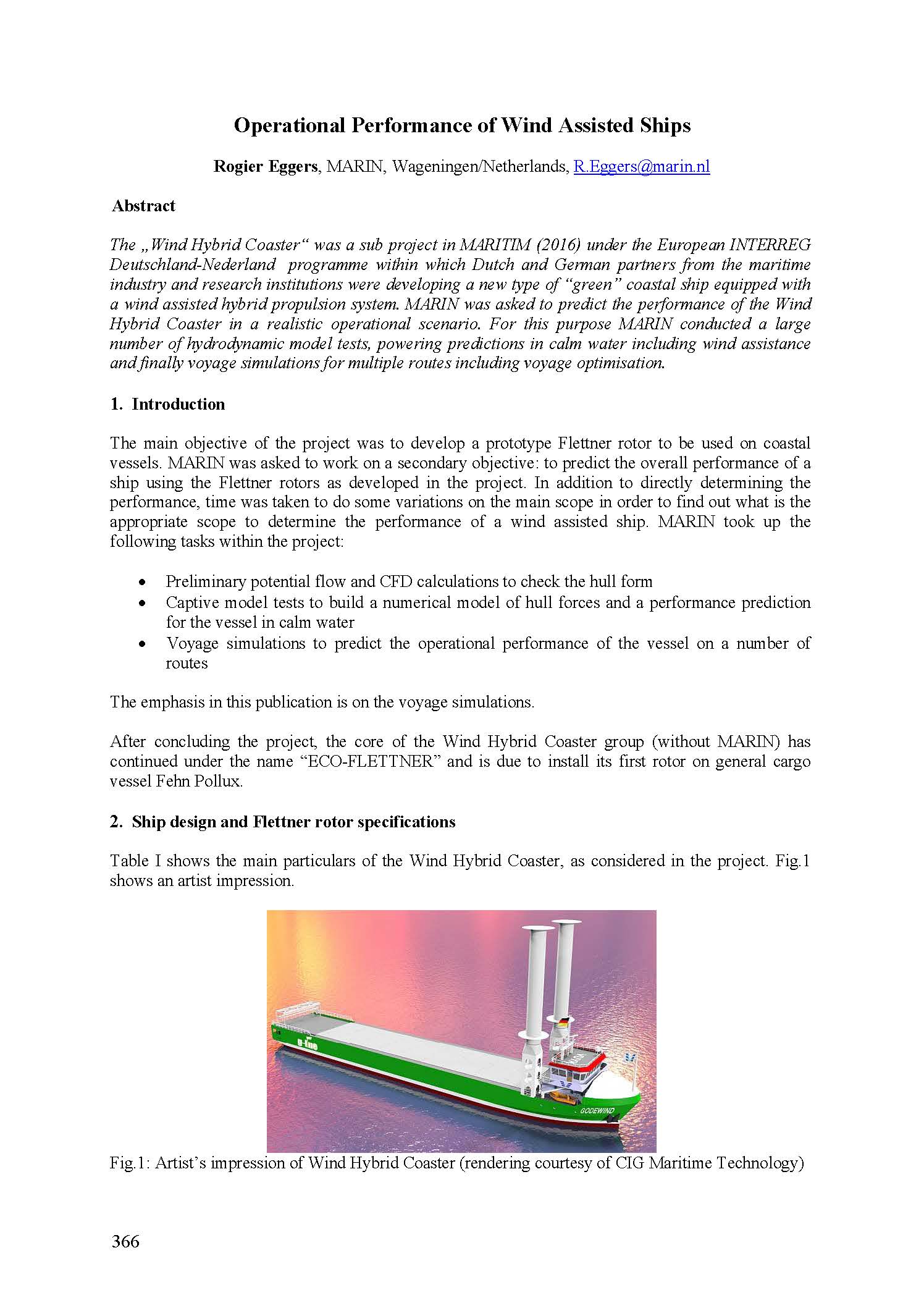
Eggers, Rogier
Operational Performance of Wind Assisted Ships Conference
10th Symposium on High-Performance Marine Vehicles (HIPER), Cortona, Italy, 2016.
Abstract | Links | BibTeX | Tags: flettner rotor, natural propulsion, wind assisted ships, wind hydrid coaster
@conference{Eggers2016,
title = {Operational Performance of Wind Assisted Ships},
author = {Eggers, Rogier},
url = {http://www.marin.nl/web/Publications/Papers/Operational-Performance-of-Wind-Assisted-Ships.htm},
year = {2016},
date = {2016-10-17},
booktitle = {10th Symposium on High-Performance Marine Vehicles (HIPER), Cortona, Italy},
pages = {366-379},
abstract = {The „Wind Hybrid Coaster“ was a sub project in MARITIM (2016) under the European INTERREG Deutschland-Nederland programme within which Dutch and German partners from the maritime industry and research institutions were developing a new type of “green” coastal ship equipped with a wind assisted hybrid propulsion system. MARIN was asked to predict the performance of the Wind Hybrid Coaster in a realistic operational scenario. For this purpose MARIN conducted a large number of hydrodynamic model tests, powering predictions in calm water including wind assistance
and finally voyage simulations for multiple routes including voyage optimisation.},
keywords = {flettner rotor, natural propulsion, wind assisted ships, wind hydrid coaster},
pubstate = {published},
tppubtype = {conference}
}
and finally voyage simulations for multiple routes including voyage optimisation.
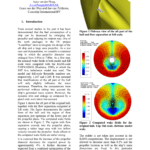
A. van der Ploeg, Bles; Zelderen, J. van
Optimization of a ship with a large diameter propeller Conference
19th Numerical Towing Tank Symposium (NuTTS), St. Pierre d'Oléron, France, 2016, 2016.
Abstract | Links | BibTeX | Tags: large diameter propeller, RANS-BEM, RANS-code
@conference{Ploeg2016,
title = {Optimization of a ship with a large diameter propeller},
author = {Ploeg, A. van der, Bles, G. van der, and Zelderen, J. van},
url = {http://www.marin.nl/web/Publications/Papers/Optimization-of-a-ship-with-a-large-diameter-propeller.htm},
year = {2016},
date = {2016-10-01},
booktitle = {19th Numerical Towing Tank Symposium (NuTTS), St. Pierre d'Oléron, France, 2016},
pages = {102-107},
abstract = {From several studies in the past it has been demonstrated that the fuel consumption of a ship can be decreased by enlarging the propeller and reducing its rotation rate. One of the work packages in the EU project "LeanShips" aims to integrate the design of the aft ship and a large area propeller. As a test case and demonstrator, we consider a container ship in which the propeller diameter was enlarged from 5.85m to 7.00m.
It is expected that the increase of the propeller diameter decreases the required power by approximately 4%. A further decrease is expected from a combined optimization of the aft part of the hull and the propeller. In this paper, we focus on the method that can be used to optimize the hull form, in which candidate hull forms will be evaluated by full-scale RANS-computations.},
keywords = {large diameter propeller, RANS-BEM, RANS-code},
pubstate = {published},
tppubtype = {conference}
}
It is expected that the increase of the propeller diameter decreases the required power by approximately 4%. A further decrease is expected from a combined optimization of the aft part of the hull and the propeller. In this paper, we focus on the method that can be used to optimize the hull form, in which candidate hull forms will be evaluated by full-scale RANS-computations.
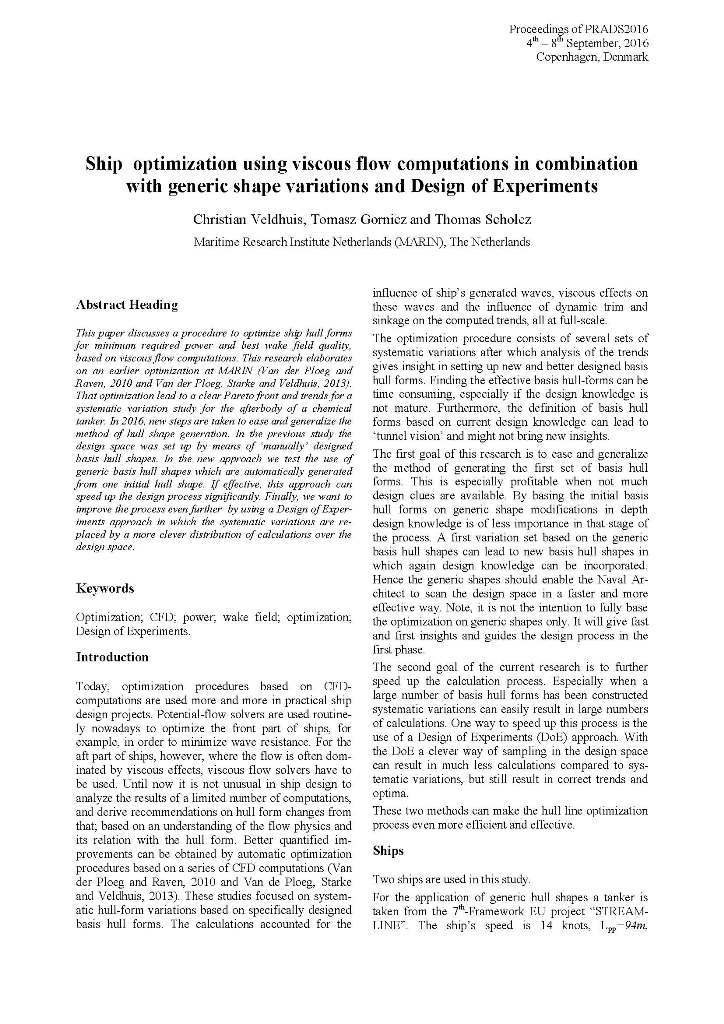
Christian; Gornicz Veldhuis, Tomasz; Scholcz
13th International Symposium on Practical Design of Ships (PRADS), Copenhagen, Denmark, no. ID080, Practical Design of Ships and Other Floating Structures 2016.
Abstract | Links | BibTeX | Tags: CFD, design of experiments, optimization, power, wake field
@conference{Veldhuis2016,
title = {Ship optimization using viscous flow computations in combination with generic shape variations and Design of Experiments},
author = {Veldhuis, Christian; Gornicz, Tomasz; Scholcz, Thomas},
url = {http://www.marin.nl/web/Publications/Papers/Ship-optimization-using-viscous-flow-computations-in-combination-with-generic-shape-variations-and-Design-of-Experiments.htm},
year = {2016},
date = {2016-09-04},
booktitle = {13th International Symposium on Practical Design of Ships (PRADS), Copenhagen, Denmark},
journal = {Proceedings of PRADS2016 4th – 8th September, 2016 Copenhagen, Denmark},
number = {ID080},
organization = {Practical Design of Ships and Other Floating Structures},
abstract = {This paper discusses a procedure to optimize ship hull forms for minimum required power and best wake field quality, based on viscous flow computations. This research elaborates on an earlier optimization at MARIN (Van der Ploeg and Raven, 2010 and Van der Ploeg, Starke and Veldhuis, 2013). That optimization lead to a clear Pareto front and trends for a systematic variation study for the afterbody of a chemical tanker. In 2016, new steps are taken to ease and generalize the method of hull shape generation. In the previous study the design space was set up by means of ‘manually’ designed basis hull shapes. In the new approach we test the use of generic basis hull shapes which are automatically generated from one initial hull shape. If effective, this approach can speed up the design process significantly. Finally, we want to improve the process even further by using a Design of Exper-iments approach in which the systematic variations are re-placed by a more clever distribution of calculations over the design space. },
keywords = {CFD, design of experiments, optimization, power, wake field},
pubstate = {published},
tppubtype = {conference}
}
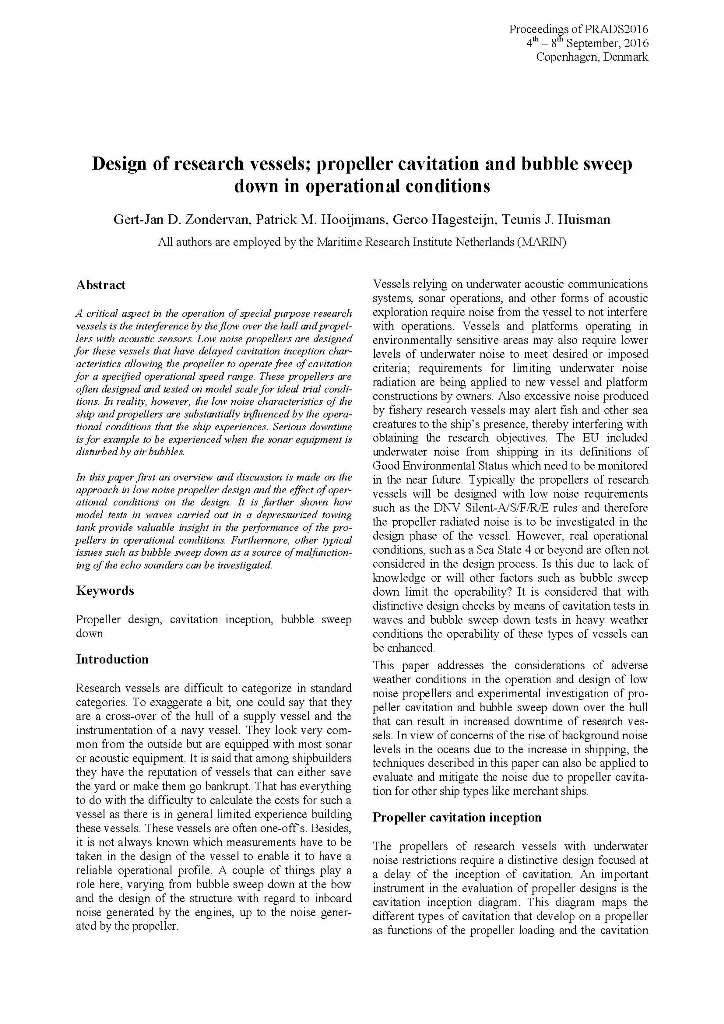
Gert-Jan; Hooijmans Zondervan, Patrick; Hagesteijn
Design of research vessels; propeller cavitation and bubble sweep down in operational conditions Conference
Proceedings of PRADS2016, 4th – 8th September, 2016, Copenhagen, Denmark, 2016.
Abstract | Links | BibTeX | Tags: bubble sweep down, cavitation inception, propeller design
@conference{Zondervan2016,
title = {Design of research vessels; propeller cavitation and bubble sweep down in operational conditions},
author = {Zondervan, Gert-Jan; Hooijmans, Patrick; Hagesteijn, Gerco; Huisman, Teunis},
url = {http://www.marin.nl/web/Publications/Papers/Design-of-research-vessels-propeller-cavitation-and-bubble-sweep-down-in-operational-conditions.htm},
year = {2016},
date = {2016-09-04},
booktitle = {Proceedings of PRADS2016, 4th – 8th September, 2016, Copenhagen, Denmark},
abstract = {A critical aspect in the operation of special purpose research vessels is the interference by the flow over the hull and propel-lers with acoustic sensors. Low noise propellers are designed for these vessels that have delayed cavitation inception char-acteristics allowing the propeller to operate free of cavitation for a specified operational speed range. These propellers are often designed and tested on model scale for ideal trial condi-tions. In reality, however, the low noise characteristics of the ship and propellers are substantially influenced by the opera-tional conditions that the ship experiences. Serious downtime is for example to be experienced when the sonar equipment is disturbed by air bubbles.
In this paper first an overview and discussion is made on the approach in low noise propeller design and the effect of oper-ational conditions on the design. It is further shown how model tests in waves carried out in a depressurized towing tank provide valuable insight in the performance of the pro-pellers in operational conditions. Furthermore, other typical issues such as bubble sweep down as a source of malfunction-ing of the echo sounders can be investigated.},
keywords = {bubble sweep down, cavitation inception, propeller design},
pubstate = {published},
tppubtype = {conference}
}
In this paper first an overview and discussion is made on the approach in low noise propeller design and the effect of oper-ational conditions on the design. It is further shown how model tests in waves carried out in a depressurized towing tank provide valuable insight in the performance of the pro-pellers in operational conditions. Furthermore, other typical issues such as bubble sweep down as a source of malfunction-ing of the echo sounders can be investigated.
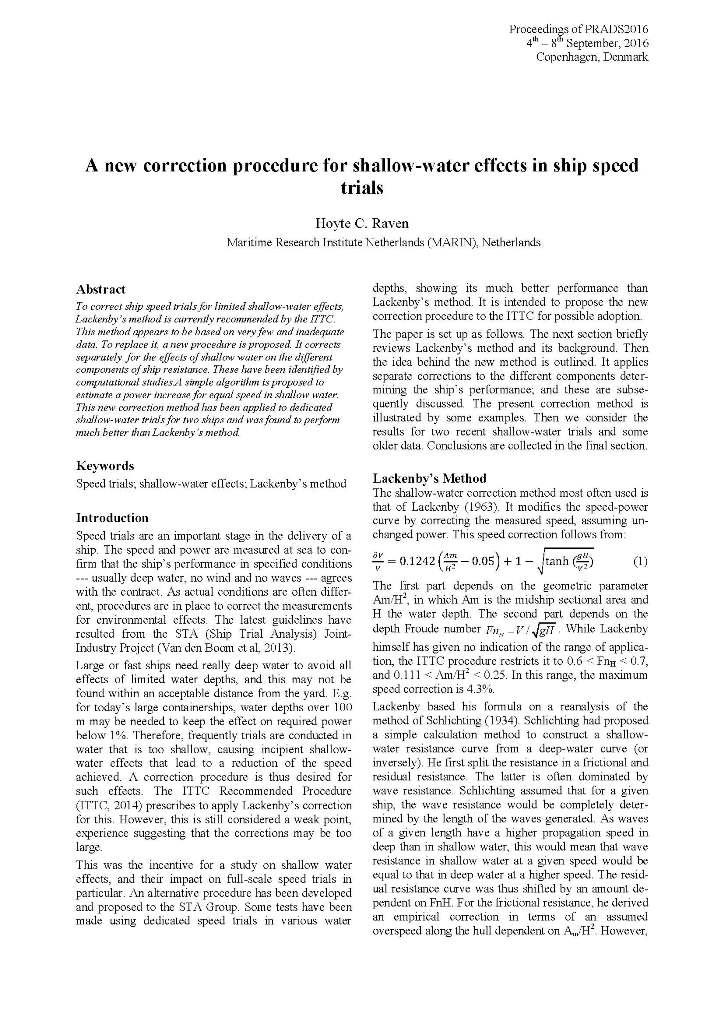
Raven, Hoyte
A new correction procedure for shallow-water effects in ship speed trials Conference
Proceedings of PRADS2016, 4th – 8th September, 2016, Copenhagen, Denmark, 2016.
Abstract | Links | BibTeX | Tags: Lackenby's method, shallow-water effects, speed trials
@conference{Raven2016,
title = {A new correction procedure for shallow-water effects in ship speed trials},
author = {Raven, Hoyte},
url = {http://www.marin.nl/web/Publications/Papers/A-new-correction-procedure-for-shallowwater-effects-in-ship-speed-trials.htm},
year = {2016},
date = {2016-09-04},
booktitle = {Proceedings of PRADS2016, 4th – 8th September, 2016, Copenhagen, Denmark},
abstract = {To correct ship speed trials for limited shallow-water effects,
Lackenby’s method is currently recommended by the ITTC.
This method appears to be based on very few and inadequate
data. To replace it, a new procedure is proposed. It corrects
separately for the effects of shallow water on the different
components of ship resistance. These have been identified by
computational studies.A simple algorithm is proposed to
estimate a power increase for equal speed in shallow water.
This new correction method has been applied to dedicated
shallow-water trials for two ships and was found to perform
much better than Lackenby’s method.},
keywords = {Lackenby's method, shallow-water effects, speed trials},
pubstate = {published},
tppubtype = {conference}
}
Lackenby’s method is currently recommended by the ITTC.
This method appears to be based on very few and inadequate
data. To replace it, a new procedure is proposed. It corrects
separately for the effects of shallow water on the different
components of ship resistance. These have been identified by
computational studies.A simple algorithm is proposed to
estimate a power increase for equal speed in shallow water.
This new correction method has been applied to dedicated
shallow-water trials for two ships and was found to perform
much better than Lackenby’s method.

Joy; Veldhuis Klinkenberg, Christian
CFD for twin gondola aft ship design Conference
Proceedings of PRADS2016, 4th – 8th September, 2016, Copenhagen, Denmark, 2016.
Abstract | Links | BibTeX | Tags: optimization, propeller, RANS-BEM, rotation direction, twin-gondola
@conference{Klinkenberg2016,
title = {CFD for twin gondola aft ship design},
author = {Klinkenberg, Joy; Veldhuis, Christian},
url = {http://www.marin.nl/web/Publications/Papers/CFD-for-twin-gondola-aft-ship-design.htm},
year = {2016},
date = {2016-09-04},
booktitle = {Proceedings of PRADS2016, 4th – 8th September, 2016, Copenhagen, Denmark},
abstract = {This paper shows a test case in the optimization for a twingondola
ship. In optimizing ships, one can optimize for minimal
resistance or for minimal power. For twin-gondola this
choice is of great importance, due to the asymmetric nature of
the flow coming into the propeller. We first show the optimization
of a twin-gondola ship for resistance only, where the
decrease in resistance is found to be 1.5%. When including the
propeller, using RaNS-BEM coupling, a large difference is
found between inward and outward rotating propeller. The
ship with the largest resistance, requires the least power if the
propeller turns in the right direction. We show that RaNSBEM
coupling could be an efficient method of taking the
propeller rotation direction into account in an optimization
process. The results are also compared to a model test of the
same ship, showing the same trend.},
keywords = {optimization, propeller, RANS-BEM, rotation direction, twin-gondola},
pubstate = {published},
tppubtype = {conference}
}
ship. In optimizing ships, one can optimize for minimal
resistance or for minimal power. For twin-gondola this
choice is of great importance, due to the asymmetric nature of
the flow coming into the propeller. We first show the optimization
of a twin-gondola ship for resistance only, where the
decrease in resistance is found to be 1.5%. When including the
propeller, using RaNS-BEM coupling, a large difference is
found between inward and outward rotating propeller. The
ship with the largest resistance, requires the least power if the
propeller turns in the right direction. We show that RaNSBEM
coupling could be an efficient method of taking the
propeller rotation direction into account in an optimization
process. The results are also compared to a model test of the
same ship, showing the same trend.
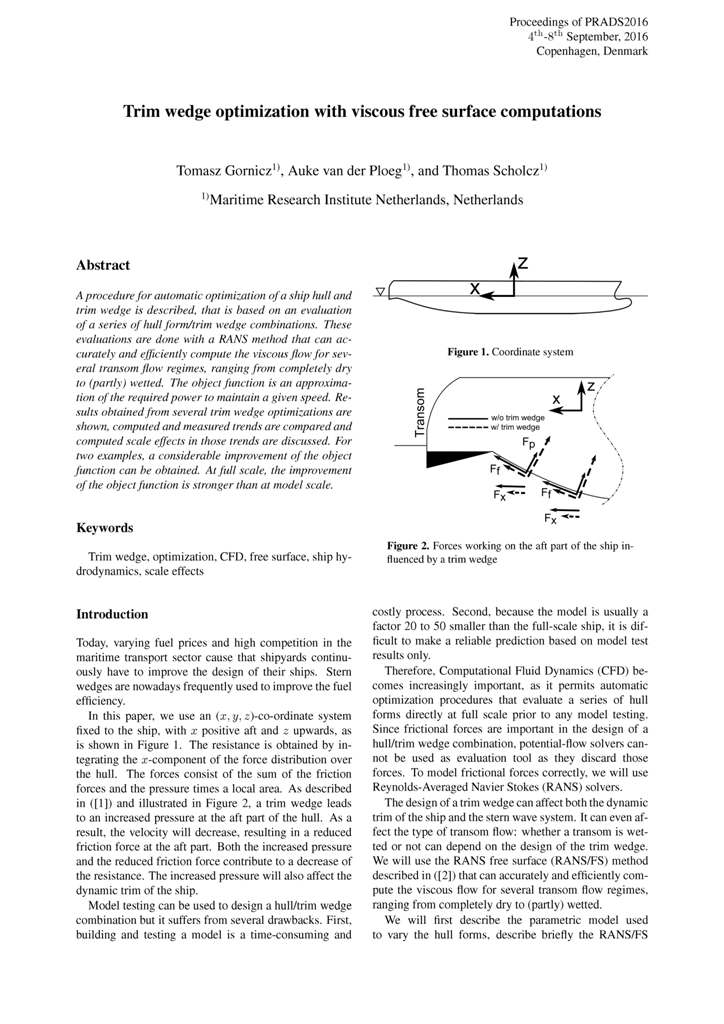
Tomasz; van der Ploeg Gornics, Auke; Scholcz
Trim wedge optimization with viscous free surface computations Conference
Proceedings of PRADS2016, Copenhagen, Denmark, 2016.
Abstract | Links | BibTeX | Tags: CFD, free surface, optimization, scale effects, ship hydrodynamics, trim wedge
@conference{Gornics2016,
title = {Trim wedge optimization with viscous free surface computations},
author = {Gornics, Tomasz; van der Ploeg, Auke; Scholcz, Thomas},
url = {http://www.marin.nl/web/Publications/Papers/Trim-wedge-optimization-with-viscous-free-surface-computations.htm},
year = {2016},
date = {2016-09-04},
booktitle = {Proceedings of PRADS2016, Copenhagen, Denmark},
abstract = {A procedure for automatic optimization of a ship hull and
trim wedge is described, that is based on an evaluation
of a series of hull form/trim wedge combinations. These
evaluations are done with a RANS method that can accurately
and efficiently compute the viscous flow for several
transom flow regimes, ranging from completely dry
to (partly) wetted. The object function is an approximation
of the required power to maintain a given speed. Results
obtained from several trim wedge optimizations are
shown, computed and measured trends are compared and
computed scale effects in those trends are discussed. For
two examples, a considerable improvement of the object
function can be obtained. At full scale, the improvement
of the object function is stronger than at model scale.},
keywords = {CFD, free surface, optimization, scale effects, ship hydrodynamics, trim wedge},
pubstate = {published},
tppubtype = {conference}
}
trim wedge is described, that is based on an evaluation
of a series of hull form/trim wedge combinations. These
evaluations are done with a RANS method that can accurately
and efficiently compute the viscous flow for several
transom flow regimes, ranging from completely dry
to (partly) wetted. The object function is an approximation
of the required power to maintain a given speed. Results
obtained from several trim wedge optimizations are
shown, computed and measured trends are compared and
computed scale effects in those trends are discussed. For
two examples, a considerable improvement of the object
function can be obtained. At full scale, the improvement
of the object function is stronger than at model scale.
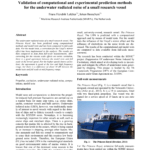
Lafeber, Frans Hendrik; Bosschers, Johan
13th International Symposium on Practical Design of Ships (PRADS), Copenhagen, Denmark, no. ID105, 2016.
Abstract | Links | BibTeX | Tags: cavitation, computations, model tests, propeller, underwater radiated noise
@conference{Lafeber2016,
title = {Validation of computational and experimental prediction methods for the underwater radiated noise of a small research vessel},
author = {Frans Hendrik Lafeber and Johan Bosschers},
url = {http://www.marin.nl/web/Publications/Papers/Validation-of-computational-and-experimental-prediction-methods-for-the-underwater-radiated-noise-of-a-small-research-vessel.htm},
year = {2016},
date = {2016-09-04},
booktitle = {13th International Symposium on Practical Design of Ships (PRADS), Copenhagen, Denmark},
number = {ID105},
abstract = {The underwater radiated noise of a small research vessel, The Princess Royal, has been predicted using computational methods and model tests and has been compared to full-scale data. For the model tests, a correction for the Lloyd’s mirror effect has been implemented in the analysis. The results are then compared to data from full-scale measurements. After correcting for the viscous scale effects on vortex cavitation, there is a good agreement between the model tests and full scale at the lowest speed. For the higher speeds (more cavita-tion), the agreement is good at the low and high frequency range, but there is a difference of about 10 dB between the model tests and full scale at mid frequency range.},
keywords = {cavitation, computations, model tests, propeller, underwater radiated noise},
pubstate = {published},
tppubtype = {conference}
}
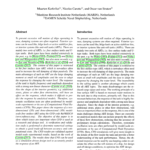
M. Kerkvliet, Carette; Straten, O. van
Analysis of free surface anti-roll tank using URANS. Verification and validation Conference
13th International Symposium on Practical Design of Ships (PRADS), Copenhagen, Denmark, 2016.
Abstract | Links | BibTeX | Tags: anti-roll tank, ART, CFD, free surface, ReFRESCO, URANS, verification and validation
@conference{Kerkvliet2016,
title = {Analysis of free surface anti-roll tank using URANS. Verification and validation},
author = {Kerkvliet, M., Carette, N. and Straten, O. van},
url = {http://www.marin.nl/web/Publications/Papers/Analysis-of-free-surface-antiroll-tank-using-URANS.-Verification-and-validation-1.htm},
year = {2016},
date = {2016-09-04},
booktitle = {13th International Symposium on Practical Design of Ships (PRADS), Copenhagen, Denmark},
pages = {ID055},
abstract = {To prevent excessive roll motion of ships operating in seas, damping systems are often required. Exterior systems can be used like, bilge keels or active stabilizer fins, or interior systems like anti-roll tanks (ARTs). There are mainly two sorts of ARTs, i.e. free surface tanks and Utype tanks. Both types have been studied extensively in the past, e.g. by Watts (1883), Frahm (1911) and Verhagen and Wijngaarden (1965), but also more recently, e.g. by Lee and Vassalos (1996), Kerkvliet et al. (2014) and Carette (2015). The content of this paper is restricted to the free surface type ART, which is nowadays often used to increase the roll damping of ships passively. The main advantages of such an ART are the large damping moment at small roll amplitudes and the ease to adapt the response by changing the water level. The response of the tank is highly frequency and amplitude dependent with a strong non-linear character (Carette et al., 2016). Also the shape of the interior geometry, e.g. additional struts, plates or other flow obstructions, will have an effect on the response, which makes it difficult to predict the response by analytical models. Therefore, systematic oscillation tests are often performed by model-scale experiments or by use of Computational Fluid Dynamics (CFD). This paper shows the response of a two-dimensional (2D) and three-dimensional (3D) model-scale free surface ART using the CFD code ReFRESCO (www.refresco.org). The objective of this paper is to show which issues are important when CFD is used as a research and design tool. A verification and validation study is performed to determine numerical settings to obtain a good trade-off between accuracy and computational costs. The CFD results are validated against model-scale experimental results, based on the work of Carette (2015). The results show that CFD can be used as a simulation driven design tool to accurately predict the response of an ART.},
keywords = {anti-roll tank, ART, CFD, free surface, ReFRESCO, URANS, verification and validation},
pubstate = {published},
tppubtype = {conference}
}
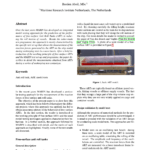
Abeil, Bastien
Experimental prediction of anti roll tanks on the rolling of ships Conference
13th International Symposium on Practical Design of Ships (PRADS), Copenhagen, Denmark, 2016.
Abstract | Links | BibTeX | Tags: Anti roll tank, ART, model tests
@conference{Abeil2016,
title = {Experimental prediction of anti roll tanks on the rolling of ships},
author = {Bastien Abeil},
url = {http://www.marin.nl/web/Publications/Papers/Experimental-prediction-of-anti-roll-tanks-on-the-rolling-of-ships.htm},
year = {2016},
date = {2016-09-04},
booktitle = {13th International Symposium on Practical Design of Ships (PRADS), Copenhagen, Denmark},
pages = {ID146},
abstract = {Over the last years MARIN has developed an integrated model testing approach for the prediction of the performance of free-surface Anti Roll Tanks (ART) in reducing the roll motion of vessels. Beside the tailor-made test programme, the approach is mostly characterised by the specific test set-up that allows the measurement of the reaction forces generated by the ART on the ship model during seakeeping tests in a wave basin. After a brief introduction of the working principle of free-surface ARTs and the MARIN test set-up and programme, the paper describes in detail the measurements obtained from ARTs during a series of seakeeping test campaigns.},
keywords = {Anti roll tank, ART, model tests},
pubstate = {published},
tppubtype = {conference}
}
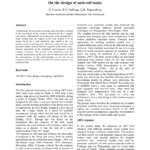
Reint Dallinga Nicolas Carette, Geert Kapsenberg
On the design of anti-roll tanks Conference
13th International Symposium on Practical Design of Ships (PRADS), Copenhagen, Denmark, 2016.
Abstract | Links | BibTeX | Tags: anti-roll tank, design, operability, seakeeping
@conference{Carette2016b,
title = {On the design of anti-roll tanks},
author = {Nicolas Carette, Reint Dallinga, Geert Kapsenberg},
url = {http://www.marin.nl/web/Publications/Papers/On-the-design-of-antiroll-tanks.htm},
year = {2016},
date = {2016-09-04},
booktitle = {13th International Symposium on Practical Design of Ships (PRADS), Copenhagen, Denmark},
pages = {ID030},
abstract = {Traditionally, the procedure to design anti-roll tanks is limited to the assessment of the reaction moment due to a regular roll motion. Although this procedure may seem adequate for a badly rolling ship, the neglect of the sway motion is by no means trivial for a well stabilized ship, which is the very purpose of the stabilizing tank. Moreover, older literature and previous studies showed that the response of the tank is non-linearly dependent on the amplitude and frequency of this complex excitation. The present work summarizes how the complex performance of the tank can be understood and what the consequences of this understanding are for the use of frequency domain methods to predict the motion response of a stabilized ship.},
keywords = {anti-roll tank, design, operability, seakeeping},
pubstate = {published},
tppubtype = {conference}
}
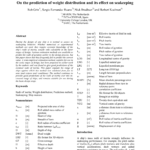
Sergio Fernandez Ruano Rob Grin, Nick Bradbeer; Koelman, Herbert
On the prediction of weight distribution and its effect on seakeeping Conference
13th International Symposium on Practical Design of Ships (PRADS), Copenhagen, Denmark, 2016.
Abstract | Links | BibTeX | Tags: Prediction method, Radii of inertia, seakeeping, Ship motions, Weight distribution
@conference{Grin2016,
title = {On the prediction of weight distribution and its effect on seakeeping},
author = {Rob Grin, Sergio Fernandez Ruano, Nick Bradbeer and Herbert Koelman},
url = {http://www.marin.nl/web/Publications/Papers/On-the-prediction-of-weight-distribution-and-its-effect-on-seakeeping.htm},
year = {2016},
date = {2016-09-04},
booktitle = {13th International Symposium on Practical Design of Ships (PRADS), Copenhagen, Denmark},
pages = {ID054},
abstract = {During the design of any ship it is normal to assess its seakeeping behavior. Whether numerical or experimental methods are used, they require accurate knowledge of the ship’s radii of inertia, usually only calculable in the latter stages of design. Various estimation methods are available to predict the radii of gyration earlier in the design process, but this paper shows that they frequently fail to predict the correct value. A semi-empirical estimation method, suitable for use in the early stages of design, has been proposed in earlier work by the authors and was found to give good predictions of the eventual radii of inertia. This paper expands the range of ships against which this method was validated from five to nine (and sixteen total conditions). The method continues to provide good predictions of the radii of inertia over this in-creased range of ships, and remains suitable for use during the basic design stage.},
keywords = {Prediction method, Radii of inertia, seakeeping, Ship motions, Weight distribution},
pubstate = {published},
tppubtype = {conference}
}
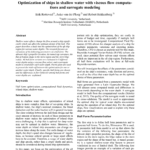
Erik Rotteveel, Auke van der Ploeg; Hekkenberg, Robert
Optimization of ships in shallow water with viscous flow computations and surrogate modeling Conference
13th International Symposium on Practical Design of Ships (PRADS), Copenhagen, Denmark, 2016.
Abstract | Links | BibTeX | Tags: Computational fluid dynamics, Hull form optimization, inland ships, shallow water
@conference{Rotteveel2016,
title = {Optimization of ships in shallow water with viscous flow computations and surrogate modeling},
author = {Erik Rotteveel, Auke van der Ploeg and Robert Hekkenberg},
url = {http://www.marin.nl/web/Publications/Papers/Optimization-of-ships-in-shallow-water-with-viscous-flow-computations-and-surrogate-modeling.htm},
year = {2016},
date = {2016-09-04},
booktitle = {13th International Symposium on Practical Design of Ships (PRADS), Copenhagen, Denmark},
pages = {ID083},
abstract = {Shallow water effects change the flow around a ship significantly which can affect the optimum design of the hull. This paper describes a study into the optimization of the aft ship region for various water depths. The research focuses on variations of the following parameters of a hull form: The athwart ship’s propeller location, the tunnel top curvature, the flat-of-bottom shape in the stern region and the stern bilge radius. All hull form variants are evaluated in 3 different water depths using a viscous flow solver, and a surrogate model is created for each water depth. Pareto plots are used to present the trade-off between the optimization for one or another water depth. Finally, specific hull forms are chosen and the differences in flow behavior among hull forms and water depths are explained.},
keywords = {Computational fluid dynamics, Hull form optimization, inland ships, shallow water},
pubstate = {published},
tppubtype = {conference}
}
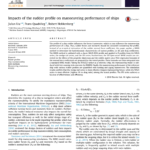
J. Liu, Quadvlieg; Hekkenberg, R.
Impacts of the rudder profile on manoeuvring performance of ships Journal Article
In: Ocean Engineering, 2016, vol. 124, pp. 226-240, 2016.
Abstract | Links | BibTeX | Tags: KVLCC2, Manoeuvring simulations, RANS methods, Rudder profiles, Ship manoeuvrability
@article{Liu2016,
title = {Impacts of the rudder profile on manoeuvring performance of ships},
author = {Liu, J., Quadvlieg, F.H.H.A. and Hekkenberg, R.},
url = {http://www.marin.nl/web/Publications/Papers/Impacts-of-the-rudder-profile-on-manoeuvring-performance-of-ships.htm},
doi = {10.1016/j.oceaneng.2016.07.064},
year = {2016},
date = {2016-09-01},
journal = {Ocean Engineering, 2016},
volume = {124},
pages = {226-240},
abstract = {The profile of a ship rudder influences the forces it generates, which in turn influence the manoeuvring performance of a ship. Thus, rudder forces and moments should be calculated considering the profile. Instead of an empirical estimation of the rudder normal force coefficient, this paper applies a RANS method to determine the hydrodynamic characteristics of various profiles, i.e. lift and drag coefficients. The RANS method is validated with a classic NACA 0012 profile and applied to 9 profiles from the NACA series, the wedge-tail series, and the IFS series. Furthermore, the 2D open-water RANS results are corrected for the effects of the propeller slipstream and the rudder aspect ratio. New regression formulas of the normal force coefficients are proposed for the tested profiles. These formulas are then integrated into a standard MMG model. Taking the KVLCC2 tanker as a reference ship, the manoeuvring model is validated with free-running tests executed by MARIN. Finally, the manoeuvring performance of the reference ship with various rudder profiles are quantified with turning and zigzag manoeuvres. The simulation results confirm that the wedge-tail series is most effective (largest manoeuvring forces) while the NACA series is most efficient (highest lift to drag ratio) among the tested profiles. The IFS series achieves a balance of effectiveness and efficiency.},
keywords = {KVLCC2, Manoeuvring simulations, RANS methods, Rudder profiles, Ship manoeuvrability},
pubstate = {published},
tppubtype = {article}
}

